5 Things to Do on Tangier Island in Virginia's Chesapeake Bay
:max_bytes(150000):strip_icc():format(webp)/Rachel-58092b055f9b58564c6639af.jpg)
Tangier Island is often referred to as the 'soft shell crab capital of the world’ and is a unique place to visit. Located on the Chesapeake Bay in Virginia, Tangier is made up of many small islands divided by marshes and small tidal streams. It is located 12 miles off of the mainland and is only accessible by boat or airplane. The island is about 1 mile wide and 3 miles long and has about 700 residents, most of whom make their living by crabbing and oystering.
There are very limited amenities on Tangier Island: a few gift shops and restaurants, one hardware store, one small grocery store, and a handful of bed and breakfasts. There are only a few cars on the island and residents get around on golf carts, boats, mopeds, and bikes. The roads are only wide enough for two golf carts to pass each other. In the summertime, visitors arrive on the island by boat and spend the afternoon exploring Tangier and learning about the culture and lifestyle of this island community of watermen. During the summer, the following ferries and cruise ships come to the island each day, allowing passengers to explore and buy goods from the Islanders.
During your visit, there are many ways to explore the Tangier Island and learn more about its unique history.

Take a Watermen’s Tour
Learn about the soft shell crabbing industry with Denny Crockett, the owner of Hilda Crockett’s Chesapeake House. The licensed captain offers a variety of tours, such as crabbing, birding, sunset, and ecotours.
Visit the Tangier Island History Museum
This museum displays historic artifacts and provides an excellent overview of the island and its community. The museum doubles as the visitor center and admission is free.
Kayak Through the Trails of Tangier
The Tangier Island History Museum provides free kayaks and canoes from its dock. Visitors can explore the self-guided “water trails” around Tangier and surrounding marshes.
Feast on Fresh Seafood
Tangier Island is one of the best places on the Chesapeake Bay for fresh, local seafood, especially soft-shell crabs. You can find all-you-can-eat crab cakes at restaurants like Chesapeake House and other crab specialties Fisherman's Corner.
Take a Bicycle or Golf-Cart Tour
Local residents line up when the boats arrive each day to offer tours around the island. Bikes, kayaks, and golf carts are available to rent and it is also easy to just walk around the island.
Virginia Beach: Planning Your Trip
First Landing State Park: The Complete Guide
9 Most Beautiful State Parks in Virginia
The Best Small Town in Every State
The 11 Best Beaches in Georgia
Best Chesapeake Bay Hotels
What to See and Do in Historic Occoquan, Virginia
The Best Beach in Every State
What to See and Do on Kitsap Peninsula
Baltimore Guide: Planning Your Trip
Assateague Island - A National Seashore Visitor's Guide
Skidaway Island State Park: The Complete Guide
Things to Do with Kids on Catalina Island
20 Best Things to Do in Washington, D.C.
Romantic Florida for Honeymoon Couples and Other Lovers
The Ultimate East Coast Beach Road Trip
Your browser is not supported for this experience. We recommend using Chrome, Firefox, Edge, or Safari.
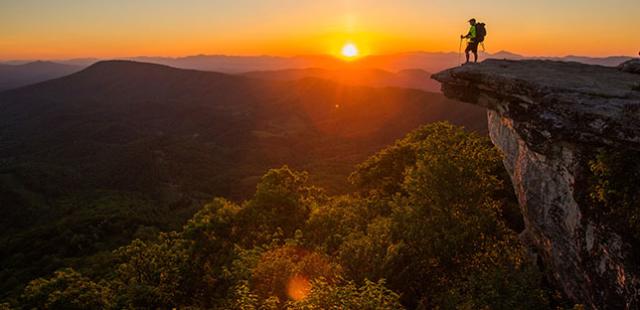
visitors guide
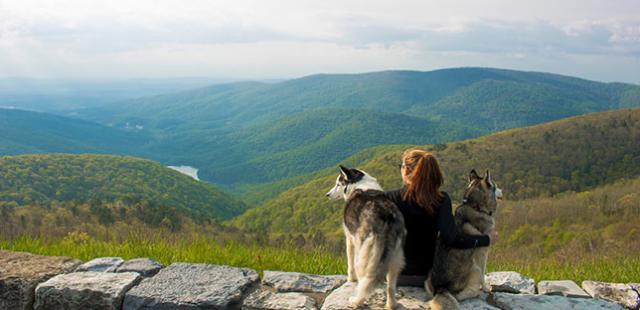
Sign up for our
Enewsletter, tangier island.
Tangier is a remote island accessible by air or sea, 12 miles out in the Chesapeake Bay. Visit the “soft crab capital” of the nation and feel welcome by the locals who take much pride in their lifestyle. See the narrow streets, traveled mostly by bicycles and golf carts, the unspoiled beach, quaint gift shops and ice cream shops. Enjoy fine dining with their fresh caught seafood and be sure to visit the Tangier Island Museum full of history on their way of life on the island.
Eastern Shore of Virginia Tourism Commission 19056 Parkway Melfa, VA 23410
(757) 787-8268
Trips of Discovery
Make the best of your journey, make some memories.
- Boating / Chesapeake Bay / ICW / Sailing / Slow Boat to Florida (SBFL) Series / Virgina
5 things to know about Tangier Island, Virginia
by Kazaz · November 18, 2019
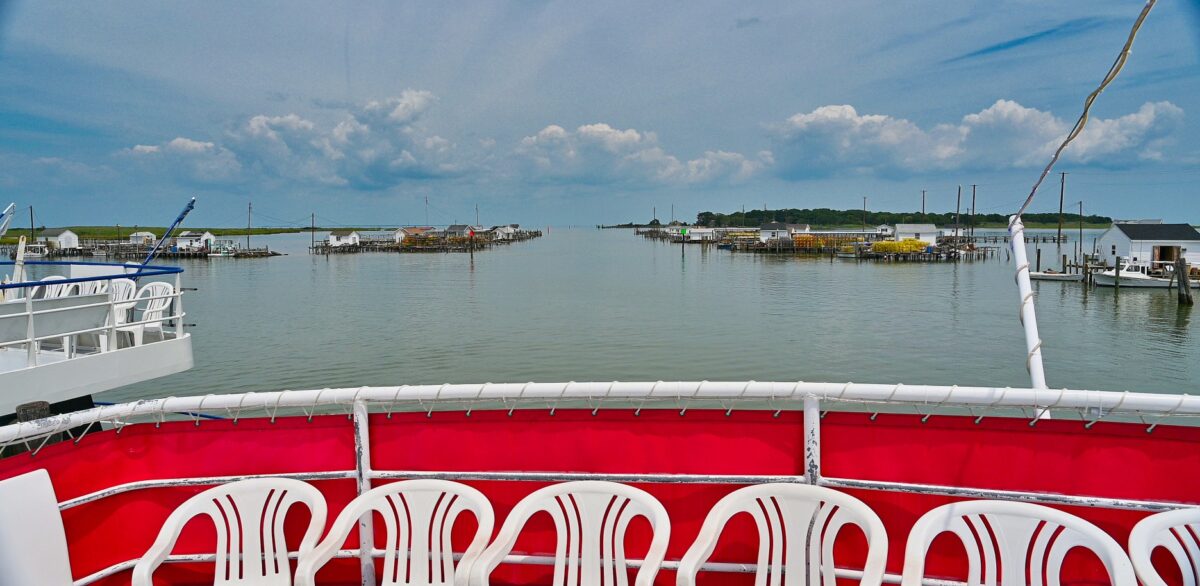
Estimated Reading Time: 12 minutes – SBFL* 5 – PLANNED & VISITED – It was a sunny day in late summer. The Chesapeake Bay waters are as green as in the Caribbean and as tame as in a pond, almost. On a midsize tour boat mostly filled with tourists, we are on our way to Tangier Island , Virginia, in the middle of the Chesapeake Bay.
Right after departure from Crisfield, Maryland, the captain’s deep voice comes over the loudspeakers, announcing a few things that he has perhaps repeated a few thousand times before. “Looking to our left,” he says, “you will notice a couple of white buildings. This is Glenwood Evans & Son Fish Company. This company supplies all the crabbers with crab pot bait. They also buy a lot of the hard crabs that come to Crisfield. There are approximately 250,000 bushels of crabs that come in Crisfield each year to be sold, and 25-30,000 bushels of clams and oysters.”
My wife and I are on a mission to find out about life on the Atlantic Intracoastal Waterway (ICW) and compare then and now, based on observations made by Dorothea and Stuart E. Jones in their 1958 National Geographic article titled, “Slow Boat to Florida” (hence the title of my SBTF* series), and a 1973 book published by National Geographic, titled America’s Inland Waterway (ICW), by Allan C. Fisher, Jr. Between the two National Geographic authors, only Fisher stopped by Tangier Island after spending some time at nearby Smith Island in 1973.
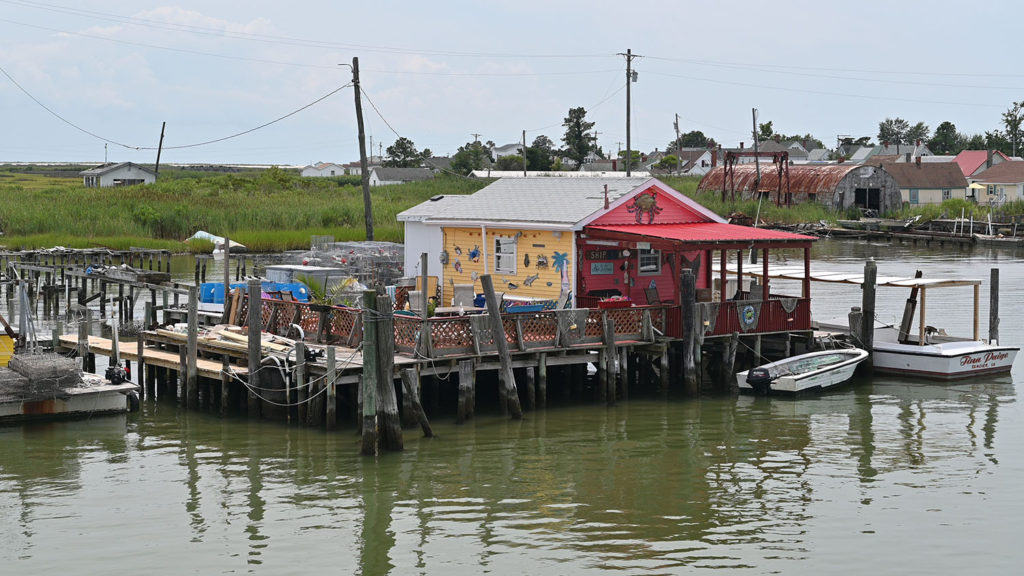
We had visited Tangier Island once a decade or so ago. It is known as the ‘soft-shell crab capital of the world’ and a majority of its residents make their living crabbing, along with tourism. The island was discovered in 1608 by Captain John Smith and was settled in 1686 by John Crocket and his family. The British occupied Tangier Island several times during the War of 1812 and used it as a base of operations. They created Fort Albion at the southern end of the island, and in 1814 more than 1,000 troops were living in the barracks there. Nearly 700 escaped slaves took refuge on the island, and the British recruited about 200 of them to join a force known as the Colonial Marines.
Independent spirit of Tangier
With the exception of the territorial flags of the US , not too many islands on the US mainland have their own flags. You can’t see it flying on the island, but Tangier does have one.
The top right elements have been adapted from the Flag of Cornwall , a.k.a. Saint Piran’s Flag. The Cornwall cross reflects the Cornish and Devon origins of most of the original English settlers back in the 17th century. A black line 1/3 of the way up from the bottom denotes the Maryland-Virginia state line and a green circle below the black horizontal line represents the island itself. Smith Island, Maryland , a nearby sister island of Tangier, has the same flag but the green dot is above the black line, denoting the location being in Maryland.
Then and now of Tangier Island
Going southbound on the lower Chesapeake Bay of the Atlantic Intracoastal Waterway (ICW) back in 1973, Fisher first visited Smith Island, then hopped over to nearby Tangier Island. Sharing his impressions, he wrote, “Walking about Tangier, I found its terrain, its houses, its people looked very much like those of Smith Island. But there are differences. Tangier has a high school and it has a government headed by Mayor Alva W. Crockett. But at present, it too lacks a doctor.”
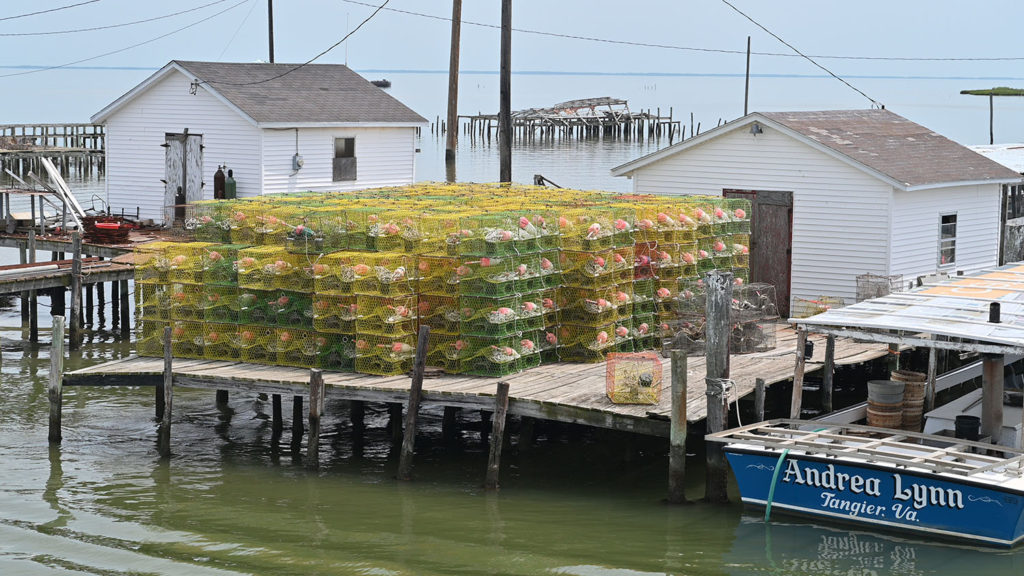
That was then. Now, in 2019, with about 400 full-time residents, Tangier Island still displays its independent spirit and they keep adapting despite their relatively isolated island and their Elizabethan accent. As someone puts it, “Among Tangier’s watermen, “high tide” sounds like “hoy toyed,” and “firkin,” an Elizabethan word for a small bucket still used by some of the older generation, sounds as if it had two or three R’s in the middle.” Apparently, many who now cater to the burgeoning tourist trade have deliberately softened the accent for uninitiated ears.
Tangier Island’s school is still kindergarten through 12th grade, having 45 students this year and 13 teachers. Most of the teachers are from the island. The school had four graduates this year. We were told that in 2020, the senior class would be one boy, Matthew Parks. They still have a government, headed by James Cooper Eskridge, also a waterman, as well as six council members, and a policeman. There isn’t a jail, but they do have a police boat to take any suspects to the mainland if someone is suspected of committing a crime. A doctor visits the island every Thursday. In addition, the doctor and a dentist visit the island sometimes on one other day. There is a nurse on the island at all times and usually a Physician’s Assistant. The island has a Volunteer Ambulance Corp like most small communities in the region. In medical emergencies requiring evacuation, just as in neighbouring Smith Island, the Maryland State Police attend to the island and can usually be on site with a helicopter within 15-20 minutes, coming from Salisbury, Maryland.
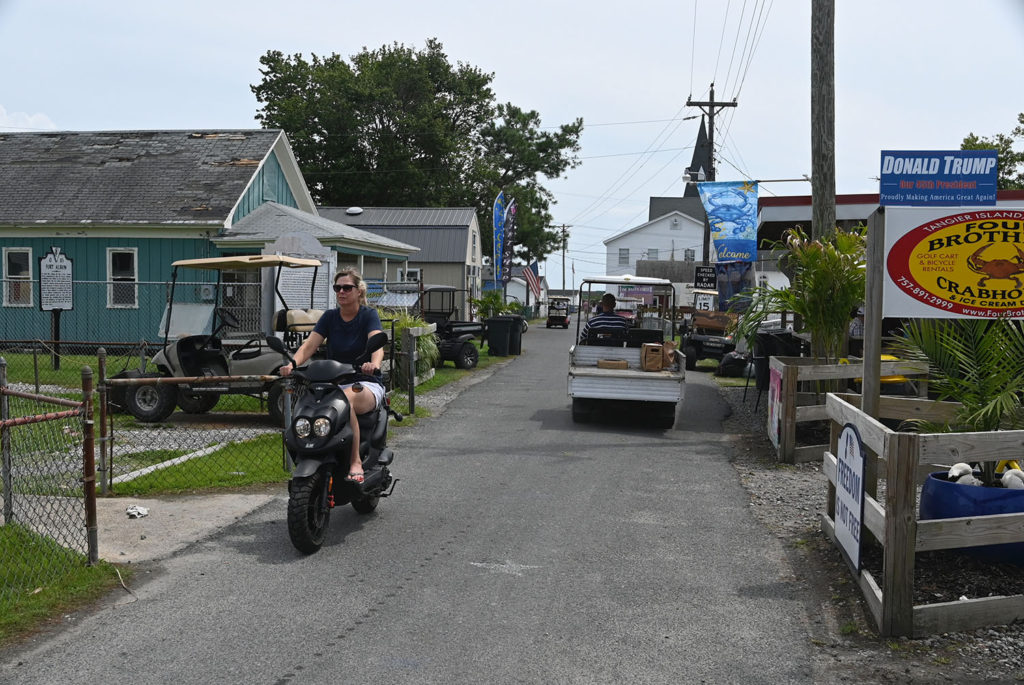
They have 15-20 cars and trucks on the island but residents prefer golf carts, bicycles, and scooters, while most all keep cars and trucks on the mainland, in Crisfield, Maryland. The island gets its water from 7 artesian wells. They have a central sewage system, sewage treatment plant and incinerator, and trash picked up two days a week. They have high-speed internet, telephone service provided through microwave, but very little cell phone service. After the tourist season ends in October, the island still has its daily mail boat. Sometimes the water around the island will freeze and there’s no way on or off the island. Then, the US Coast Guard will cut through the ice to bring the island food and supplies. One of the older houses on the island is well over 100 years old. The oldest cemetery on the island dates back to the 1700s.
If you have a small airplane, the airport, year around, is waiting for you
The island has a 2,300-foot-long airport designed for small aircraft. There are no scheduled flights in or out of the island at the airport; however, it stays very busy with over 80 flights a month.
While there are other seasonal May through October accommodations on the island, the Bay View Inn near the airport is the only hotel open year-round. Similarly, Lorraine’s Seafood Restaurant is the only one open year-round. (We can definitely recommend their crab cakes!)
Living on the island and the reality of the 21st century
My wife and I walked down the main street, just taking in the environment and occasionally focusing in on chatter between the tourists and the islanders. I suppose because of the effects of climate change and news coverage on these shallow patches of the lower Chesapeake Bay, which have been having quite a bit of flooding, sooner or later people ask about it. Striking up a conversation with a young islander, a visitor says she was so surprised to find out that Tangier Island belongs to Virginia. The islander responds, “Yeah, however, we’re closer to Maryland than Virginia. I wish we were in Maryland.” Hearing this, I could not help but jump into the conversation and ask, “Why?” The response was very telling. Apparently familiar with Maryland’s extensive efforts to deal with rising waters, erosion, and sinking of the land, in which the State built a sizable seawall and a new pier on Smith Island, the islander said, “…well, we would have been treated better. The last three Virginia governors came to the island. They have been promising a seawall. Nothing came through.” Meanwhile, the island sometimes experiences serious flooding, just as in Venice, Italy, threatening the way of life, as well as the properties, of this historical island.
Next, we walk towards the shore of the James Parks Marina. We spot a woman waiting for a boat. We strike up a conversation with her. Her name is Donna Crocker and she is one of the relatively new islanders.
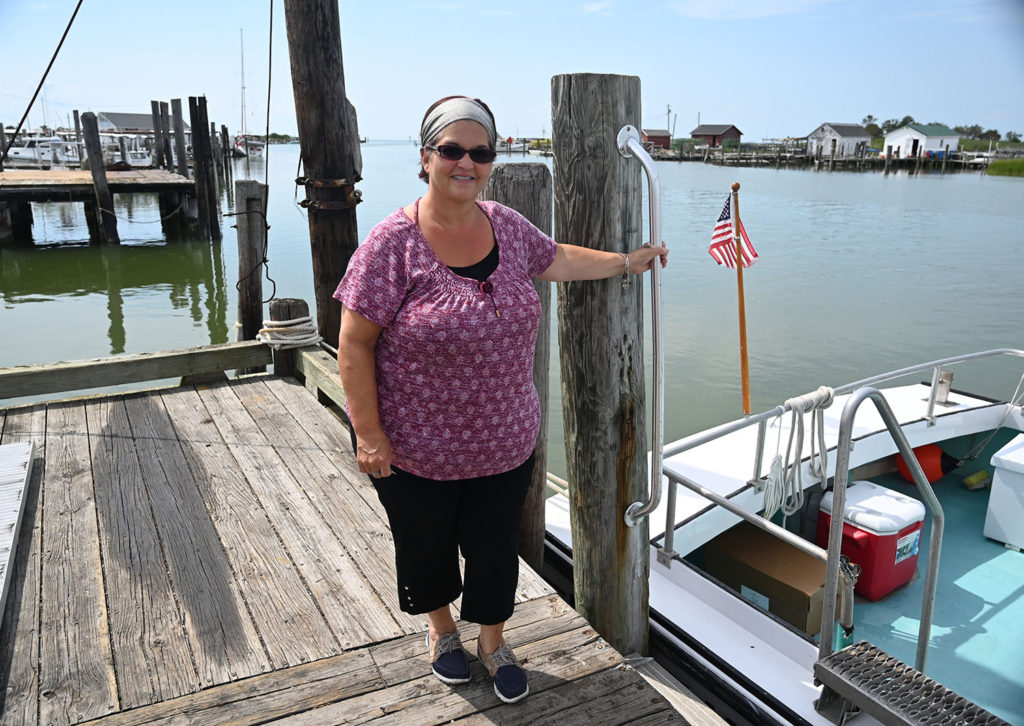
She was dating someone from the island and ended up marrying and moving to Tangier Island six years ago. I ask her what she feels about her life on the island. Her response was quick, certain, and enthusiastic. “I just love it,” she says, “I mean, I love everything about it. Everybody asks me that and, I mean, I don’t have a specific, I just love it.” She says when she gets up in the morning, she doesn’t hear the street noises like in the city and she adds, “You hear seagulls. You know, you get up and it’s so serene and peaceful. Sometimes you hear the watermen going out on the bay and stuff. It’s just beautiful.”
We turn next to Captain Mark Haney, whose charter boat is docked at the pier. After greeting him, we ask how long he has been on the island. He says he was born and raised there. His grandfather moved to Tangier Island when his father was two years old. They were both watermen. Hanley was a waterman as well, but in 2008, he started his boat charter business that is used mostly by locals. He does run seven days a week, once a day, and also does special charters at other times.
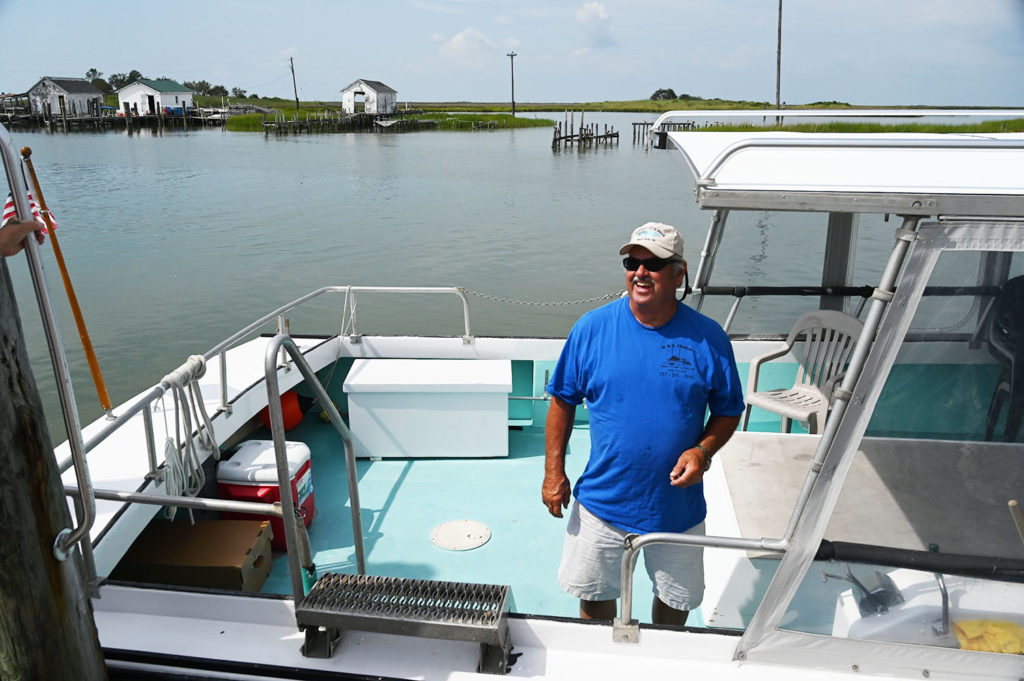
I ask him about living on the island. Obviously, he has a choice; he can live anywhere he chooses to, especially given that the waters are slowly rising. Captain Haney’s response is very simple and straightforward, “This is my home. I was born and raised here. I enjoy it.” He has two adult sons, one lives in Crisfield and the other joined the US Navy. I asked him if they are coming back to the island. He said there’s “no future here in the waterman business anymore… So slowly, slowly, the waterman business is dying. It’s dying. I would say they’ve lost 60% of the watermen in the last 25 years.” He explains that back then, there used to be 15 to 18 crab processing plants in Crisfield. While approaching by boat, one would see steam everywhere. Now there is only one left there. To me, it is odd that watermen are going out of business while the demand for seafood is going up everywhere. Captain Haney thinks that’s because now the seafood, clams, and oysters from fish farms and from foreign sources are everywhere.
I also ask him why they need a policeman in such a small island. He says, “We’re like everywhere else. We have a few problems, some drinking problems, have some drug problems, just like anywhere else.”
Sergeant John W. Charnock
I was happy to find and talk to the island’s policeman. Based on America’s Inland Waterway , Allan Fisher’s book, the Tangier Police Department’s history goes back at least to 1973. Well, we found him, right in front of a home that he was born, raised, and continues to live in. His name is Sergeant John W. Charnock.
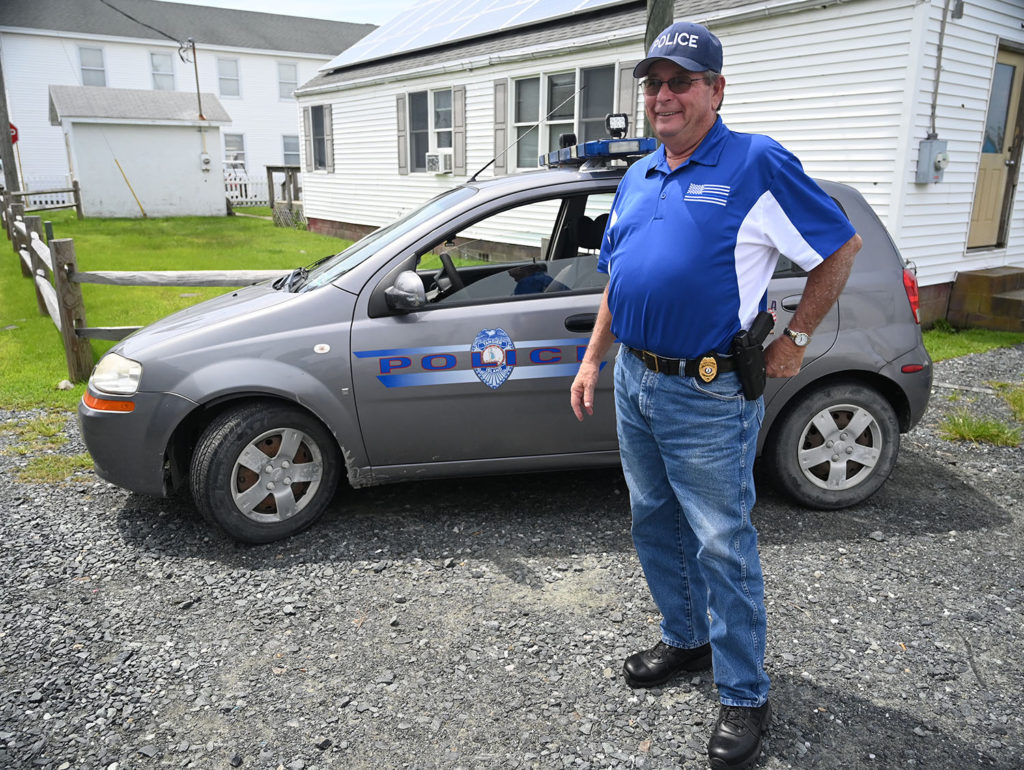
Sergeant Charnock has been in charge of the island’s police affairs for almost the past ten years. I asked him how one becomes a policeman on the island. “I was a commercial fisherman before. When this job came up, the Mayor and the council both asked me if I would go to the police academy and take the job,” said Sergeant Charnock. “So you were born here?” He replied, “I was born and raised here. Right in this building there.” He added, “My whole family, as far as I can go back, we’re born and raised right here.”
From our previous visit, I knew Smith Island did not have a policeman. I wonder why Tangier, another tight-knit island community, needed one. The Sergeant said, “There are more people here. The more people you get, the more problems you’re going to have.” I got curious – is it because of more tourists or just the locals? “We don’t have much trouble with visitors. It’s all locals. We have a lot of domestics, some breaking in and entry now and then. We have a little bit of everything on a small scale, everything but homicide, no homicide.”
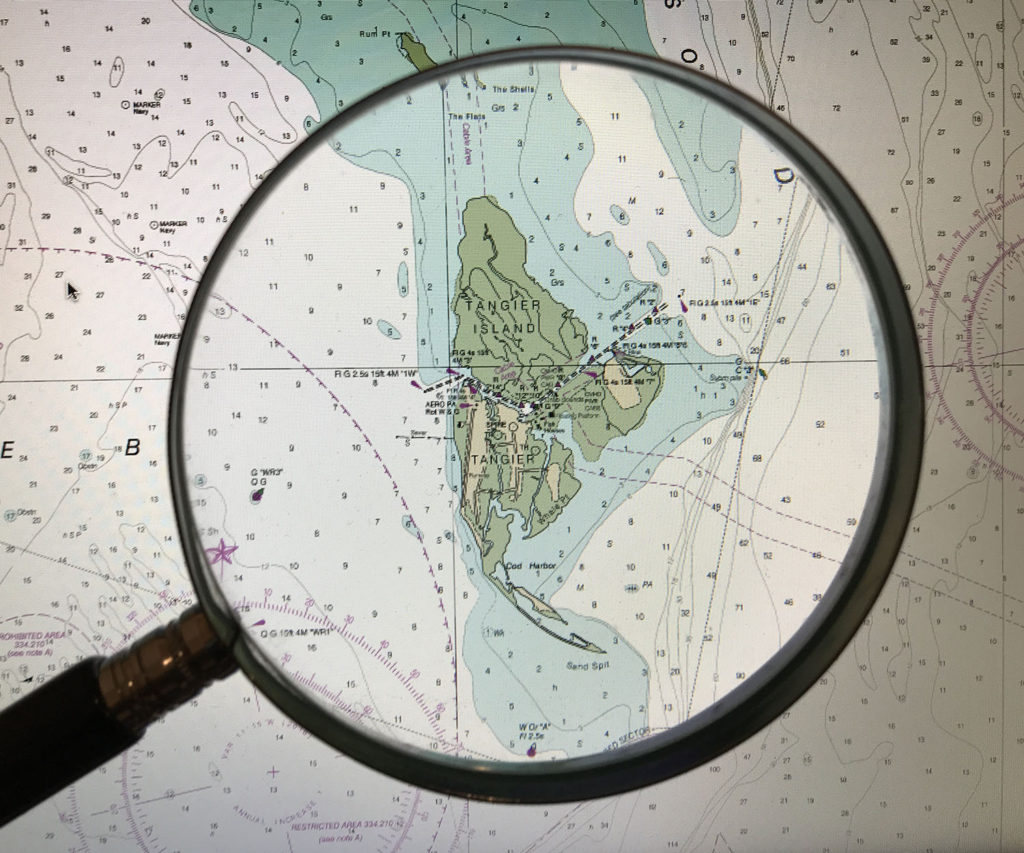
I asked, “So what’s the most exciting thing that happened within the last year as far as the police were concerned?“ His answer was very reassuring and frank, “Well, nothing real exciting takes place. We don’t have a lot of action around here. That’s good.” Referring to the size of Tangier, Sergeant Chernock said, “I only have about just a little over a mile to cover, so I can keep my eye on everything pretty much.” He is the only one in the town police department. However, they have two marine police officers covering the water. He said, “If something gets a little out of hand, we all get together and deal with it.” The more I talk, the more I get curious. I asked, “When was the last time you needed to get together?” He said, “Once in a while, you’ll have parties where a lot of alcohol is involved and people get a little rowdy.” If needed, the team takes suspects to the mainland with the marine police’s boat.
Tangier goes international
Lately, Tangier has become a melting pot of US as well as international tourists. WBOC, a Local TV station tell it all on their Tangier Island Grabs International Attention segment.
In 2018 alone, international visitors and film crews from 22 nations visited the island, which is highly welcomed. However, some islanders wonder why there is such international attention on their little island.
With this, we completed our short day visit to Tangier Island, with the hope that we would come back again and spend a few days in the future.
I hope to say hello to you and shake your hand if you spot my boat, Life’s AOK in one of my locations that I will be visiting.
I bid you Fair Winds and Following Seas.
3 things I learned
- The population of Tangier was 727 at the 2010 census.
- If you do not have the patience or the desire to take the land and boat ride route to the island, the Tangier Island Airport is a perfect alternative to get in and out of the island with small aircraft.
- Tangier Island has a Volunteer Ambulance Corp like most small communities. There is a nurse on the island at all times and usually a PA. A physician is on the island on Thursdays. In medical emergencies requiring evacuation, the Maryland State Police attends to the island and can usually be on-site within 15-20 minutes.
5 things I recommend
- Take the short guided and narrated golf cart tour of Tangier Island . It will give you a quick overview of life on the island. Don’t wonder how you can locate them. You will see them as soon as you get off the tour boat.
- Orient yourself with a map of Tangier Island.
- Visit the Tangier History Museum & Interpretive Cultural Center. It is located at 16215 Main Ridge, just south of Spanky’s Ice Cream Parlor on the East side of the road.
- Consider paddling through the Tangier Island water trails . Tangier Island offers a unique opportunity to explore the marshes, discover wildlife, and view the workings of the Chesapeake Bay watermen.
- If you want more information about anything on Tangier Island , such as accommodations, restaurants, tours, eco tours, sunset cruises, and travel to Tangier, you can use this form or simply send your email to [email protected] .

Marina where you can tie your boat on the ICW
- There are 25 slips in the James Parks Marina , complete with electric and water hookup plus onshore showers. This is the spot to stop. Also, there is docking available at the County Dock for loading and offloading.
Places to stay, besides your boat
Try this link: VisitSmithIsland.com
*SBFL stands for Slow Boat to Florida. It is a series of my blog posts, which started with a posting that had the same title. Each numbered heading has two parts. The first is “Planned,” and when we visit the planned location, a “Visited” label appears at the beginning, next to SBFL. The essence of this series is not to seek new lands and exotic cultures. Rather, it is to cover our journey of discovery (hence the title of our blog Trips Of Discovery) that has to do with seeing with a new eye the coastal locations of the Atlantic Intracoastal Waterway (ICW) where present-day America started to flourish. The SBFL series represents part travel, part current and historical anthropological highlights of selected locations and coastal life. We’re comparing then and now, based on observations made by Dorothea and Stuart E. Jones in their 1958 National Geographic article titled, “Slow Boat to Florida” and a 1973 book published by National Geographic, titled America’s Inland Waterway (ICW) by Allan C. Fisher, Jr. We also take a brief look at the history of the locations that I am writing about. Finally, we bundle it up with our observations during our actual visits to the locations and our interviews with local residents. Think of it as a modest time capsule of past and present. My wife and I hope that you, too, can visit the locations that we cover, whether with your boat or by car. However, if that is not in your bucket list to do, enjoy reading our plans and actual visits as armchair travelers anyway. Also, we would love to hear from you on any current or past insights about the locations that I am visiting. Drop me a note, will you?
3 Responses
- Pingbacks 1
Good info. Lucky me I recently found your website by chance (stumbleupon). I’ve saved as a favorite for later!
This article is truly a good one it assists new net users, who are wishing for blogging.
[…] after visiting Smith Island on the Maryland side, went to neighboring Tangier Island, hence entering the waters of the Virginia part of the Chesapeake Bay. He planned to continue down […]
Leave a Reply Cancel reply
Your email address will not be published. Required fields are marked *
TripsofDiscovery.com
Save my name, email, and website in this browser for the next time I comment.
This site uses Akismet to reduce spam. Learn how your comment data is processed .
- Next story Plan to visit Sultana this summer in Chestertown
- Previous story Awesome undertakers, barbers, repairmen, hunters and $1,144,600

SITE SEARCH
Stories you may have missed, u.s. department of homeland security – united states coast guard – navigation center.
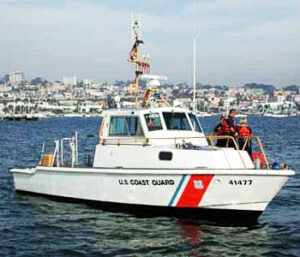
The Boating Chronicle – Read our weekly news of interest

Domestic Travel During COVID-19 | Information for People Traveling within the United States and U.S. Territories

You will not be in your boat all the time
Enquire about kismet to rent.
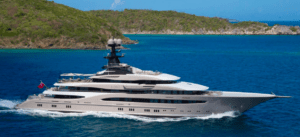
Subscribe and receive new blog post notifications
The essence of Trips of Discovery is not to seek new lands and exotic cultures. Rather, it is to cover our boating journey of discovery that comes from seeing what was always just over the horizon with a new eye. Below is our Slow Boat to Florida Series, reflecting the spirit of our site.
- Recent Posts
- Popular Posts

Richmond Hill, GA – A Tranquil Haven Along the Atlantic Intracoastal Waterway

Sailing into the historic charm of Savannah, GA – A boater’s passport to Georgia’s oldest city and its southern elegance

In the Heart of Thunderbolt, GA – Where Southern hospitality meets the supernatural

Dock, dine, and dive into the endless summer – Hilton Head Island, SC

Take a break from your ICW voyage and indulge in the charms of Charleston, SC

Stay and play – an endless summer adventure – Myrtle Beach, SC

America’s Happiest Seaside Town—Southport, NC

The Ale Trail of Wilmington, NC – Take the challenge

Wrightsville Beach, NC – Elevate your beach experience and have every day be an exceptional day

Beaufort, NC – Make sure to pronounce it as BOW-fert
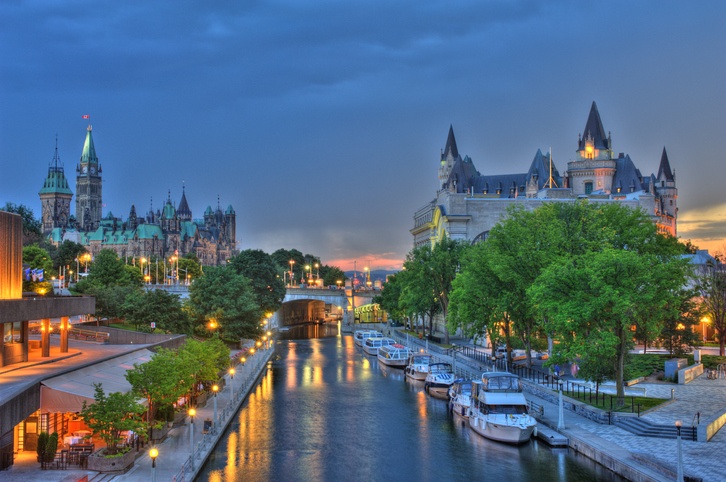
Tips for cruising through America’s Great Loop – Part 1
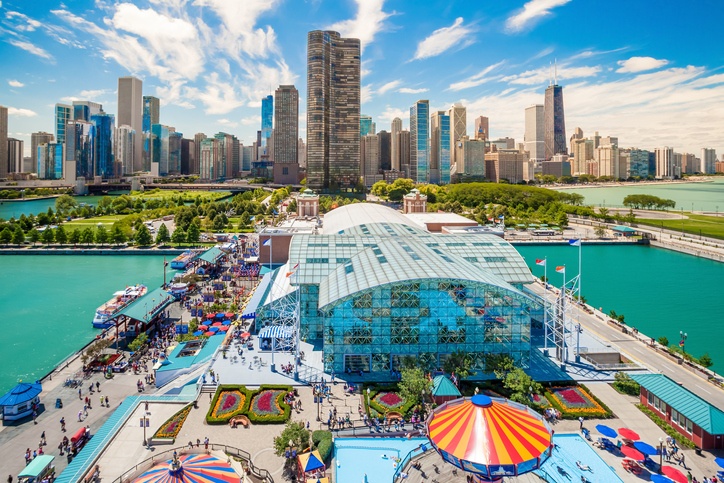
Tips for cruising through America’s Great Loop – Part 2
Tips for cruising through America’s Great Loop – Part 3
- (ABR) A Boater’s Rendezvous with… A Boater’s Rendezvous. A Boater’s Rendezvous with... Adventure AGLCA America's Great Loop America’s Great Loop Cruisers’ Association A trip Boat Boating Boat Life Boat trips Buying a boat Coastal Living Coronavirus Covid-19 Cruising Day trips with kids Denmark Discovery Donate Family Fun Fun trips Heritage Historical Towns Iceland ICW Lifestyle Looper North Carolina Olympics Pirates Planning for ICW Trip Planning for the Great Loop Sailing Slow Boat to Florida Slow Boat to Florida (BFL) Series Social distancing South Carolina The trip planners Tips for your vacation planing Trips U.S. Sailing UV Rays Watersports
- Skip to global NPS navigation
- Skip to the main content
- Skip to the footer section

Exiting nps.gov
Tangier island.
NPS / Copping
Beach/Water Access, Benches/Seating, Bicycle - Rental, Boat Ramp, Canoe/Kayak/Small Boat Launch, Dock/Pier, Ferry - Passenger, Food/Drink - Restaurant/Table Service, Gifts/Souvenirs/Books, Groceries/Convenience Items, Historical/Interpretive Information/Exhibits, Information, Internet/WiFi Available, Restroom, Scenic View/Photo Spot, Supplies - General, Water - Drinking/Potable
A Small Island With a Storied Past
Tangier is a low-lying island, barely visible above the expansive waters of the Chesapeake Bay . However, this small island is home to a community of watermen and women whose ancestors have lived here since colonial times. Surprising stories emerge from the island's history, from the Native Americans who came here to hunt and fish to the enslaved African Americans who escaped to the island to find their freedom.
Visiting Tangier
Tangier Island is only accesible by private boat or ferry. Catch a ferry from one of these locations: Onancock , Virginia (Eastern Shore) Reedville , Virginia (Western Shore) Chrisfield, Maryland (Eastern Shore) Find detailed information about ferry rides here. Visit the Tangier Island website for a comprehensive guide to travel, lodging, ammenities, and activities available on the island. Learn about the TANGIER ISLAND HISTORY MUSEUM here.
Tangier's History
Native americans on tangier.
Shell middens, or waste piles of oyster shells, and many stone points discovered on the island reveal that Indigenous peoples visited Tangier Island. They likely came here to take advantage of the summer's rich bounty of fish and shellfish.The Pocomoke people of the Bay's Eastern Shore were among the groups that could have traveled here. They would have reached the offshore island in dugout canoes, the largest of which could reach 70 feet long.
Colonial Settlement
Among the first Europeans to observe the island, John Smith and his crew spotted Tangier and its neighboring islands during their voyage throughout the Bay in the summer of 1608. With a penchant for naming the places he visited, Smith called the islands the Russell Isles, after a member of his crew, Doctor Russell. As early as the 1670s, colonists held patents to the island, which they primarily used to graze livestock. A century later, the first permanent residents arrived on the island. At first they made their living by farming, but fishing, crabbing, and oystering soon took over as their primary occupation.
War of 1812
For nearly 1,000 slaves during the War of 1812, Tangier Island was a fortress of salvation, and the place where they took their first free steps. Fort Albion, named after the ancient name for England and Commodore George Cockburn ’s flagship, was constructed on the island in 1814 to serve two major functions: as a central base to sustain continued British attacks along the Chesapeake, and as a depot for receiving runaway American slaves into citizenship and service to His Majesty, King George III of England.
Using America’s slaves against itself was not a novel idea – the British successfully employed this war tactic during the Revolutionary War. However, in the War of 1812, American slaves were considered free British citizens as soon as they set foot on British soil (which included forts and vessels), as slavery was illegal in all British territories. The new recruits remained neither American nor enslaved in the eyes of the British. Some slaves stole boats or canoes and met British troops directly; others started fires to get the attention of British soldiers for rescue. In some cases, these slaves took up arms as part of an active offense, while in others they simply took the opportunity presented by the British to escape bondage.
As early as 1813, British army and navy officers were instructed to “provide shelter, protection, and evacuation to refugees.” Admiral Alexander Cochrane formalized the policy in April 1814, with a proclamation offering the “choice of either entering into His Majesty’s Sea or Land Forces, or of being sent as FREE Settlers to the British Possessions in North America or the West Indies.”
With an anticipated influx of new recruits, the Royal Navy needed a new base. Tangier Island provided an easy access point in the Chesapeake to the Upper and Lower Bays, as well as the Potomac, Washington and Baltimore, while being surrounded by slaves in the plantation country of Virginia and Maryland. Fort Albion included a barracks, a hospital, a church, family dwellings and gardens, meant to accommodate not just prospective soldiers, but the families they brought with them as well. From its earliest inception, Fort Albion was conceived not just as a place for military training, but a place which would be a temporary home for newly freed Britons.
Tangier Island was not employed long; the War of 1812 ended less than a year after Fort Albion was built, on February 17, 1815. As the British withdrew, Cockburn ordered that “on no account [is] a Single Negro [to] be left, except by his own request,” fully embracing the status of the former slaves – whether in service or not – as free subjects of the British Empire. On March 21, 1815, the evacuation of the British from the island was completed, and Fort Albion and its barracks were burned. Former slaves were sent as soldiers and citizens to settle British colonies in the Caribbean and Canada.
Between the fort’s intentional destruction and subsequent unintentional destruction by storms and floods common in the Chesapeake, nothing remains of Fort Albion today. Much of Tangier Island where it stood has eroded, leaving a sandy beach reminiscent of those that slaves saw as they set foot on the island, in search of freedom.
Captain John Smith Chesapeake National Historic Trail , Chesapeake Bay , Star-Spangled Banner National Historic Trail
You Might Also Like
- captain john smith chesapeake national historic trail
- chesapeake bay
- star-spangled banner national historic trail
- underground railroad
- chesapeake gateways
- star spangled banner national historic trail
- war of 1812
Last updated: February 15, 2024

Tangier Island: Step back in time and explore…
Share this:.
- Click to share on Facebook (Opens in new window)
- Click to share on X (Opens in new window)
e-Pilot Evening Edition
- Things to do
Things To Do Travel
Tangier island: step back in time and explore the quaint, unspoiled fishing village.
On a summer day that felt more like fall, I finally made my way to a tiny island in the Chesapeake Bay. Tangier aka the “soft-shell crab capital of the world” located off the Eastern Shore in Accomack County, Va. was delightful.
The five-mile-long island between Virginia and Maryland is home to more than 600 people. Tangier is actually three tiny islands connected by tidal flats.
My trip to Buzzard’s Point Marina located at the tip of the Northern Neck in Reedville, Va. took less than two hours. The Chesapeake Breeze ferry owned by Captain Linwood Bowis departed sharply at 10 a.m.
Eighty-one passengers seated themselves either on the upper deck or inside the cabin of the cruise ship. I very carefully navigated myself around both.
The Captain, who also served as the cruise narrator, provided interesting tidbits while manning the helm. He gave me a thrill and let me start the engine, blow the horn, and steer the 100-foot vessel.
Bowis informed me that the journey would take a wee bit longer due to the three-to-four-foot swells.
There was a crisp fall breeze so I took my scarf out of my tie-dyed backpack and tossed it around my neck. Since the boat was rockin’ and rollin’, I had to plan my movements wisely so as not to take a tumble.
On the upper deck, I mingled with members of Kingsland Baptist Church which is located in Chesterfield. Kingsland’s social butterfly Delores Carnes organized the bus trip for 25 of their “Silver Saints.”
Deacon William Pearce checked an item off of his bucket list. He had lived in Virginia all of his life and had never been to the quaint island.
“The Lord blessed us with a beautiful day,” said Pearce.
Carnes, who ventures to the island three or four times a year, commented on how the Island has gotten a lot smaller over the years.
According to an article published this year on storymaps.arcgis.com written by Millie Thompson, Tangier Island is slowly being washed away due to climate change and erosion. She predicts that islanders’ homes will more than likely be underwater and unlivable in the next few decades.
Gloria Ollice from the Shenandoah Valley traveling to Tangier for the seventh time is fearful that it won’t be around forever.
“We love it out here. It’s a fascinating place, and we want to enjoy it before it’s too late,” said Ollice. “I’m 75, so it probably won’t happen in my lifetime.”
Before making my way over to meet a new fur friend, I mapped out a safe route with objects to grab to keep myself steady.
New Yorkers Alex and Yelena Timashu and their 4-month-old Boxer Eva vacationing in Virginia added Tangier Island to their itinerary. The motionless canine looked as nervous as a cat in a room full of rockers. I wondered if she was feeling a wee bit nauseous like some of the other passengers.

First Mate Raymond Palazzo made frequent rounds offering Emotion Eez to anyone who felt like tossing their waffles. “We’re going to keep your bellies full,” he said.
Susan Kalanges and her daughter Susie both of Chester rubbed the oil behind their ears and reported that the essential oil worked immediately.
Plastic chairs which were screwed together and bolted down by their back legs kept trying to take flight. The seas were so rough that I got sprayed in the face a few times.
Palazzo assisted at least one person to the stern, rear of the ship, to help control the passenger’s seasickness.
Thank goodness I never felt like pitching my cookies. I actually ate some delicious gluten-free ones baked by passenger Joe Crowley of Bon Air. He made them with toasted coconut, cream cheese, and a lime juice glaze.

Waterman’s crab shanties stacked with crab pots lined the shoreline as we approached the island. The airstrip was visible in the distance. Seagulls were either soaring or perched on pier posts keeping a close eye on the next wave of tourists.
After the ship docked at the Tangier Island Parks Marina, I walked a short distance and was greeted by friendly islanders offering $5 tours in Tangier taxis. I politely declined and hustled a few feet to the Four Brothers Crabhouse restaurant to rent a golf cart. There weren’t any available, so I took advantage of the 15-minute tour.
Tazewell native Sylvia Parks Bonniwell was my guide. It was money well spent, but she was so speedy that taking quality photos was impossible. We drove by three different great white herons strolling along, but “lead foot” was on a roll.
It was really quite unusual how gravesites were located in islanders’ yards. According to Bonniwell, they still have the option to bury loved ones on their own property.
After the tour, I walked around the narrow streets all snap-happy capturing its beauty and scenes from the tight-knit community.
Golf carts, scooters, and bicycles are the main mode of transportation. Locals zip around town waving and talking to each other in Old English dialect.
The Tangier History Museum has a $3 admission fee, but you won’t be disappointed. It is full of artifacts, photos, and you can watch a 17-minute video to learn about Tangier’s role in our Country’s history, their unique language, and how they face the challenges of a shrinking island and dwindling population.
On a map hanging on the museum wall, Polly Burns and her daughter Elliana Burns placed a pushpin on their hometown Reed City, Mich.
The kind Tangier History Museum volunteer Andy Langley loaned me his golf cart. This was a major score! Thanks to his generosity, I was able to make the best out of the two-and-a-half-hour visit.
If there were speed limit signs, I zipped right past them. Having learned from Bonniwell that the island doesn’t have a police presence, I got gutsy and traveled at warp speed. Ha!
After my self-guided tour, I headed to Lorraine’s Seafood Restaurant to try some fresh seafood. On the way there, an ambulance turned onto Main Street. I felt pretty confident that stumbling upon an ambulance in action on Tangier Island was pretty rare.
Everyone calls me ‘Ooker’

Mayor James “Ooker” Eskridge who was seated upon his scooter toting a basket containing his Chesapeake Bay harvest informed me that a local had died a few days prior. The ambulance was picking up her body to carry to the mainland on the mail boat.
Having embraced the small-town vibe, I asked Ooker if it was Emma. You’re probably wondering how in the world I knew the deceased’s identity. I read a notice posted on the church door about the viewing, funeral, and luncheon.
Ooker was headed home to his crab shanty on the south end of the island after he picked up items delivered by the mail boat that he had ordered from the mainland.
“The mail boat leaves at 8 and returns around 1:30,” said Ooker. “They deliver hardware, groceries, passengers, whatever needs to come and go.”
Ooker, 63, was born and raised on Tangier Island and has been mayor for the past 14 years. Since nobody seems interested in being mayor, he doesn’t have to spend any money campaigning.
“I’m a crabber first … oysterman, crabber, fisherman. Being mayor doesn’t pay the bills,” said Ooker. “I’m not really busy up at the town office. We have a wonderful town manager, so he gets into the nuts and bolts of everything.”
The mayor spends his time trying to get the story of Tangier out there. His favorite things about the island are the people and their way of life and of course crabbin’ and fishin’.
Ooker shared their harvest seasons: hard crabs — March into December, soft-shell crabs May into October, and oysters December through February.
“There’s very little time off … but you know … we’re our own boss and captain, so if we want to take a few days off sometimes, we do it,” shared Ooker. “That’s one of the benefits of being a captain.”
Ooker laughed when a local drove by on her golf cart and said, “Believe nothing he says.”
The Mayor asked tourists that had jumped in on our conversation if the boat ride over was a little rolly. “Did you put your sea legs on before you left,” asked Ooker.
“I didn’t take any Dramamine, but I should have,” said a tourist.
Petersburg native Jim Smith of Chester visiting Tangier for the first time found it very interesting, and he fell in love with the crab cakes at Lorraine’s Seafood Restaurant.
“He’s been to New England and lived in Boston, and he thought they were the best that he’s ever eaten,” said Smith’s wife Karen. “We both enjoyed the golf cart tour and listening to their accents.”
Seafood to die for

Ollice highly recommended that I try the crab cakes at Lorraine’s, however, since I’m allergic to shellfish, I opted for a fried flounder sandwich. It was the best I had ever eaten … I kid you not. As I was eating it, I seriously was thinking about ordering a second one to go. Don’t even get me started on Lorraine’s waffle sweet potato fries.
After I woofed down my scrumptious meal, I headed back to the ship. I met a local along the way…third-generation islander Richard Brown whose ancestors were from Baltimore and not England. “We’re the only Browns on the Island,” said Brown who was sporting a Trump hat.
Most everyone is related and shares one of a handful of surnames that trace back to the island’s settlement in 1778. Three last names dominate in Tangier: Crockett, Pruitt, and Parks.
Deborah Seargeant of Chester was relaxed on the dock sipping some Orange Crush taking in every second before she had to board the ship.
“I went into the Methodist Church and the gift shops,” said Seargeant. “People were really friendly. I bought some t-shirts, a coffee cup, and a Christmas ornament.”
Seargeant, not wanting to get wet again, rode inside the cabin on the way back to Reedville.
Susan Kalanges commented that she would like to have had more time to spend in the museum. I, too, would like to explore it more.
Since the pandemic, the “Silver Saints” were the first group on the Chesapeake Breeze in two years.
The 90-minute trip took an extra 10 minutes. I highly recommend the Tangier Island Cruise. It has been family-owned by the Captain’s family for 50 years … and it shows.
The next time I visit, I will more than likely spend the night so I can take my time taking it all in. The town has markers placed throughout the island that I would love to read, and I would definitely visit their beach.
Whether you travel to the unspoiled fishing village Tangier Island listed on the National Register of Historic Places by air or sea, you are sure to remember your trip for a long time to come.
Ferry reservations are recommended. Chesapeake Breeze carries passengers daily from May through October. Round-trip ticket prices: Ages 13+ $28, 4-12 $13, and 0-3 free. One-way ticket: Ages 13+ $20, 4-12 $10, and 0-3 free. Food and drinks are permitted on the boat. There is a small add-on charge to store your bike.
Visit tangiercruise.com to learn more about the Chesapeake Breeze and tangierisland-va.com for information about Tangier Island.
More in Travel

Business | The latest in go gear from the 2024 Travel Goods Show

Science | Is it safe to fly during the solar eclipse? Here’s what experts have to say.

Travel | Lush foliage, dazzling beaches, deep traditions put Fiji’s hundreds of islands on the map

SUBSCRIBER ONLY
Travel | airbnb updates cancellation policy: what travelers need to know, trending nationally.
- Photos show Key Bridge wreckage at bottom of river
- Laguna Beach High investigating AI-generated inappropriate photos of students
- Social media reacts as UConn women’s basketball reaches Final Four for 23rd time
- Former Buffalo Bills cornerback Vontae Davis found dead near home gym, according to 911 audio
- Florida’s 6-week abortion ban will have nationwide impact, critics warn
Explore Tangier Island

Plan Your Trip to Tangier Island: Best of Tangier Island Tourism
Essential tangier island.

- Fisherman's Corner Restaurant
- Four Brothers
- Muddy Toes Cafe
- Lorraine’s Sea Food

11 Things to Do on Tangier Island
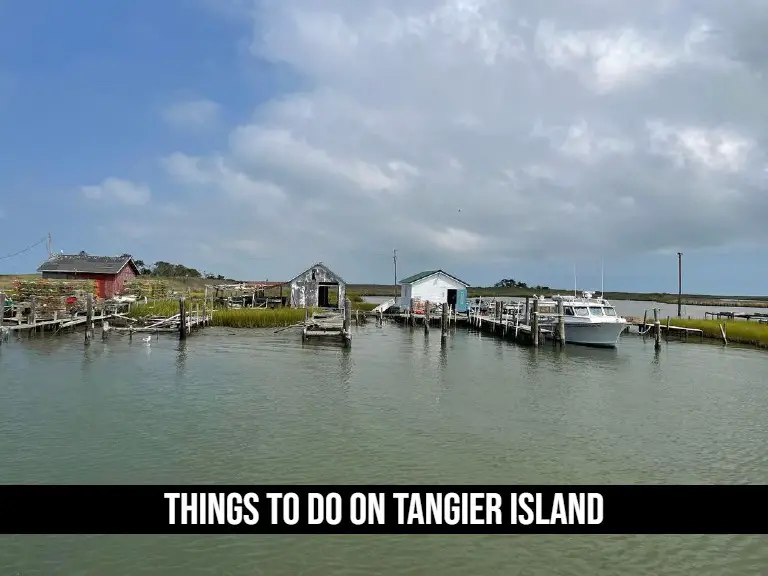
Nestled in the heart of the Chesapeake Bay, Tangier Island is a hidden gem waiting to be explored. With its rich history, unique culture, and breathtaking landscapes, it’s a destination that promises an unforgettable adventure.
Whether you’re a history buff, a nature lover, or someone in search of tranquility, Tangier Island has something to offer. The possibilities are endless, from kayaking through serene waterways to indulging in the island’s famous crab cakes.
Ready to uncover the secrets of this captivating island? Join us as we embark on a journey to discover the top things to do on Tangier Island, where every path leads to a discovery and every moment is a treasure waiting to be found.
Discover Tangier Island: The Soft Shell Crab Capital
Tangier Island often hailed as the “ soft shell crab capital of the world ,” is a fascinating destination nestled in Virginia’s Chesapeake Bay. Comprising many small islands, Tangier is a place where nature’s beauty meets a rich cultural heritage.
Getting to Tangier Island
Accessing Tangier Island is part of the adventure. In the summer, visitors can reach the island via ferry services, cruise ships, or even small planes.
A unique perspective of the Chesapeake Bay is provided by each mode of transportation, offering an unforgettable experience.
A Glimpse of Island Life
Tangier is home to around 700 residents, most of whom earn their living through crabbing and oystering. For generations, the community has been deeply intertwined with the water reflected in its way of life. Tangier has few amenities, such as restaurants, gift shops, and a small grocery store.
Cars are a rarity; residents prefer golf carts, boats, mopeds, and bikes. Modern living gives way to a slower, more authentic pace here. The narrow roads, wide enough only for two golf carts to pass, add to the island’s unique charm.
11 Entertaining Things to Do on Tangier Island
Adventure awaits: outdoor activities on tangier island.
Tangier Island is not just a place to relax and enjoy the serene surroundings; it’s a hub for outdoor enthusiasts. Nature, the unique landscape, and the culture of the island offer visitors a variety of activities to explore.
1. Kayaking Through the Trails of Tangier: A Unique Experience
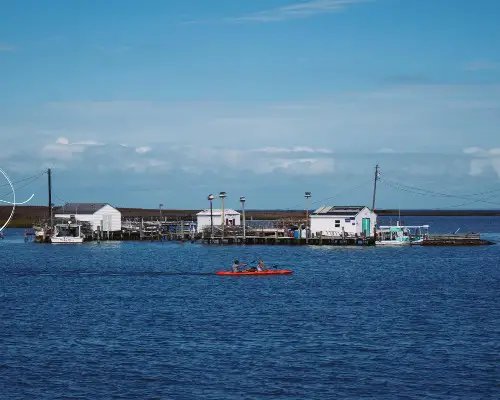
Kayaking on Tangier Island is an experience like no other. The Tangier Island History Museum provides free kayaks and canoes from its dock, allowing visitors to explore the self-guided “water trails” around Tangier and surrounding marshes.
You’ll discover hidden coves and observe wildlife in their natural habitat while paddling through calm waters. Whether you’re a novice or an expert, the trails of Tangier offer an intimate connection with nature.
2. Exploring by Golf Cart: Family Fun on the Island
Golf carts are a primary mode of transportation on Tangier Island. With roads only wide enough for two golf carts to pass, exploring the island by golf cart is a delightful experience for the whole family. Residents line up when the boats arrive each day to offer tours around the island.
Rentals are available, and it’s a fun way for teens to try their hand at driving in a safe environment. A golf cart tour provides a leisurely way to see the sights, learn about the island’s history, and interact with the friendly locals.
3. Southern Beach: A Secluded Paradise
The southern beach of Tangier Island is a hidden gem, boasting the nicest sands on the Chesapeake. A large population of seabirds on the beach is easily accessible from land or water.
Here, you can enjoy a tranquil walk along the shore, collect seashells, or simply relax and watch the waves. It is a natural beauty spot that is free of crowds and commercialization, which adds to its allure.
4. Fishing and Crabbing: A Marine Wildlife Adventure
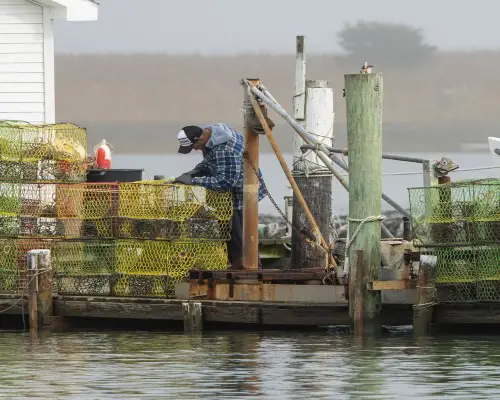
Tangier Island is renowned for its marine wildlife, particularly its abundance of fish and crabs. Fishing and crabbing are not just hobbies here; they are a way of life. Visitors can spend hours sitting on a pier with a fishing rod or a chicken neck on a string, bringing in the catch of the day.
Guided fishing tours offer insights into Tangier’s fishing community. It’s a hands-on experience that connects you with Tangier’s maritime history whether you’re an angler or a novice crabber.
Savor the Flavors: Culinary Delights on Tangier Island
Tangier Island’s culinary scene is a reflection of its maritime heritage. This picturesque island in the Chesapeake Bay offers an abundance of fresh seafood prepared using traditional recipes. From succulent crab cakes to freshly caught fish, the flavors of Tangier are sure to tantalize your taste buds.

1. Feast on Fresh Seafood: Best Places to Eat

Tangier Island is one of the best places on the Chesapeake Bay for fresh, local seafood. The restaurants on the island serve farm-to-table dishes made from the day’s catch. All-you-can-eat crab cakes are a specialty at places like Chesapeake House and Fisherman’s Corner.
Dining on Tangier Island is a celebration of the sea, whether you’re eating oysters, clams, or soft-shell crabs. Intimate, family-run eateries offer incredible food in a warm, welcoming environment.
2. Tangier’s Famous Crab Cakes: A Must-Try
Tangier Island’s crab cakes are legendary. In Tangier, the capital of soft-shell crabs, crab cakes are known for their quality and flavor. Fresh blue crabs are cooked into crab cakes using a blend of herbs and spices to enhance their natural sweetness.
Lightly breaded and perfectly cooked, they offer a taste sensation that’s both rich and delicate. Tangier is a culinary hotspot for crab cakes, which are considered a must-try dish by many visitors. In either form, Tangier’s crab cakes are a testament to the island’s culinary expertise.
Dive into History: Tangier’s Rich Heritage
Tangier Island offers an enriching experience steeped in historical significance. With its blend of Native American roots and European influences, Tangier’s rich heritage is a tapestry that reveals the evolution of American coastal life.
Tips: Explore the island on foot or rent a bike to experience its historic charm. Don’t forget to chat with the locals—they’re the living history of the island!
1. Tangier Island History Museum: A Journey Through Time
The Tangier Island History Museum is a must-visit for history enthusiasts. It houses artifacts, photographs, and documents that date back to the early 17th century.
- Native American Era: Uncover the secrets of the original inhabitants.
- Colonial Times: Trace the footprints of English explorers and settlers.
- Modern History: Discover how Tangier played a role during the World Wars and its current preservation efforts.
Note: Admission fees are nominal, and guided tours are available for more in-depth experience.
2. Watermen’s Tour: Understanding the Crabbing Industry
The Watermen’s Tour is a fascinating excursion into Tangier’s vibrant crabbing industry. Here’s why it’s a can’t-miss:
- Learning Experience: See how crabs are caught, sorted, and prepared.
- Meet the Watermen: Talk to local fishermen, whose families have been in the business for generations.
- Fresh Seafood: Enjoy a meal made from crabs caught on the same day.
Tangier Island’s crabbing industry contributes to nearly 13% of Virginia’s total crab harvest .
Family-Friendly Attractions: Fun for All Ages
Tangier Island is not just a destination for history and seafood lovers; it’s a place where families can create memories together. With an array of activities suitable for children, teenagers, and adults, there’s never a dull moment on this captivating island.
1. Golf Cart Exploration: Safe Driving Experience for Teens

Navigating Tangier Island on a golf cart is not just convenient but also a unique and enjoyable experience. Teens can safely explore the island’s picturesque streets and hidden gems by driving under supervision.
- Rent a Golf Cart : Various local businesses offer rental services.
- Guided Tours: Opt for a guided tour to learn about key attractions.
- Explore on Your Own: Get a map and make your adventure!
2. The Cat Population of Tangier: A Quirky Attraction

Believe it or not, the cats of Tangier Island have become an attraction in themselves! These feline friends can be spotted lounging around town, often striking photogenic poses.
- Cat Watching: Enjoy observing the variety of cats and their unique personalities.
- Cat History: Learn about how the cat population became a quirky characteristic of the island.
- Photography Opportunity: Capture these adorable creatures in your vacation photos.
A visit to Tangier Island can be enhanced by the presence of 500 cats .
3. Tangier History Museum: Hands-On Learning Experience
While the Tangier Island History Museum offers deep insights into the island’s past for adults, it also provides hands-on learning experiences for children. Here’s what to expect:
- Interactive Exhibits: Children can touch and explore artifacts.
- Educational Workshops: Engaging workshops tailored for younger visitors.
- Treasure Hunts: Organized scavenger hunts that make learning fun.
- Family Programs: Special programs designed to engage the entire family.
Creative List of Must-See Exhibits
- The Pirate’s Cove: Explore a replica of a pirate ship.
- Time Travel Tunnel: Walk through different eras of Tangier history.
- Art of the Sea: Participate in sea-inspired craft sessions.
Tangier Island offers a perfect blend of fun, learning, and adventure, making it a family-friendly destination. You can explore the island by golf cart, meet its quirky cats, and engage with history hands-on.
Best Time to Visit Tangier Island: A Personalized Guide
When it comes to visiting Tangier Island, timing can be everything. Your ideal time will depend on what you seek—whether it’s mild weather, open attractions, or aligning with the ferry schedule. Here’s a breakdown of what various sources suggest:
- Summer Sojourn (May to August): Summer on Tangier Island offers pleasant temperatures, ranging from 61-72°F (16-22°C), especially enjoyable in May. But be warned, the progression of summer may lead to an increase in bugs and jellyfish.
- Prime Time (Mid-April to Mid-October): Many attractions and services are open during this period. It encompasses the warmer months, ensuring a comfortable and vibrant experience.
- Top Choice (May to July): Some travelers argue that the months from May to July are the golden window for visiting Tangier Island. Favorable weather and optimal travel conditions make this period particularly appealing.
- Ferry Considerations : Your visit might hinge on the ferry schedule if that’s your chosen mode of transport. Running at 10 am and 5 pm daily and returning around 4:30 pm, aligning your plans with the ferry can maximize your island time.
- Weather Watch: Keep an eye on the weather, especially if you prefer milder temperatures or want to avoid certain seasonal creatures.
- Attractions and Accessibility: Check what’s open if you’re visiting outside of mid-April to mid-October to avoid disappointment.
- Plan Around the Ferry: If arriving by ferry, make sure your itinerary aligns with the schedule for a seamless experience.
By considering these factors, you can tailor your visit to Tangier Island to your preferences, whether seeking the best weather, the most attractions, or just a well-timed ferry ride.
Q1: How do I get to Tangier Island?
A: Tangier Island can be reached by taking a ferry or private boat from either the Virginia mainland or Maryland. The most common departure points are from Reedville, Virginia, or Crisfield, Maryland. It is recommended to check the ferry schedules and make reservations in advance, especially during peak tourist seasons.
Q2: Are there any accommodations available on Tangier Island?
A: Yes, Tangier Island offers a few accommodations, including bed and breakfasts, vacation rentals, and a couple of inns. Because accommodations can be limited during the summer months, it is advisable to book well in advance.
Q3: Can I bring my own bicycle or kayak to Tangier Island?
A: Yes, you can bring a bicycle and kayak to Tangier Island. The island is bicycle-friendly, and kayaking is a popular activity. However, if you prefer not to bring your equipment, rentals are available on the island.
Q4: Are there any guided tours available on Tangier Island?
A: Yes, Tangier Island offers guided tours, led by knowledgeable locals who can share insights into the island’s unique history, culture, and ecosystem. These tours often cover various points of interest, such as the island’s historic sites and crabbing/fishing experiences.
Q5: Can I camp on Tangier Island?
A: No, Tangier Island does not offer designated camping facilities or areas for visitors. Accommodations typically include bed-and-breakfasts, hotels, and vacation rentals. Always check with local authorities or tourism offices for the most up-to-date information on lodging options.
Q6: Is Tangier Island suitable for families with children?
A: Yes, Tangier Island can be a great destination for families with children. The island’s small size and slow pace make it safe and manageable for families to explore together. The island’s nature also lends itself to crabbing, fishing, and wildlife watching for children.
Q7: How long should I plan to spend on Tangier Island?
A: The duration of your stay on Tangier Island depends on your preferences and the activities you wish to engage in. You’ll be able to enjoy various activities and fully immerse yourself in the island’s atmosphere if you spend a night or two on the island.
Tangier Island, with its blend of history, nature, and community charm, is an undiscovered gem off the Virginia coast. The essence of the island lies not only in its family-friendly activities, local quirks, and travel tips but also in its friendly residents. The community’s connection to the sea, traditions, and each other adds an invaluable layer to the visitor’s experience.
As a result of the diversity of activities on Tangier Island, it caters to history buffs, nature enthusiasts, families, and explorers alike. It is the combination of these facets that makes the island a unique and enriching destination, no matter when you choose to visit.
BayDreaming.com
Your guide to the chesapeake bay, tangier island, virginia, getting to tangier island.
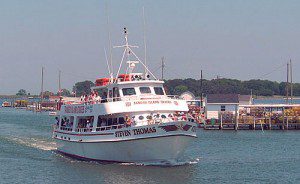
The “Steven Thomas” leaves Crisfield daily at 12:30, arrives at Tangier at 1:45, leaves Tangier at 4:00 and returns to Crisfield at 5:15. More information on Steven Thomas Cruises .
You can also take the mail boat “Courtney Thomas” from Crisfield to Tangier. This boat leaves the Crisfield town dock at 12:30 Monday through Saturday.
The “Chesapeake Breeze” leaves Reedville at 10:00am and returns to Reedville around 3:40. The boat leaves from Buzzard’s Point Marina. It takes about an hour and a half to get to Tangier. More information about the Chesapeake Breeze .
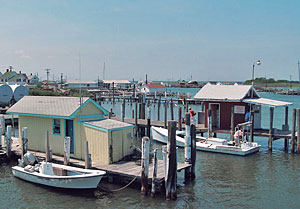
A seasonal passenger ferry operates from the picturesque town of Onancock on Virginia’s Eastern Shore. This passenger ferry service runs from May through September. You’ll ride out to the island on the “Joyce Marie II,” a 36 foot lobster boat, similar to a traditional Chesapeake Bay deadrise. The boat’s captain, Mark Crockett is a friendly native Tangierman. The boat leaves from the Onancock Wharf, located at the end of Market Street. More information about the Onancock to Tangier ferry .
These round-trip cruises provide a nice trip on the Bay and several hours to visit Tangier. These cruises are quite popular and summer days can bring hundreds of visitors to the island.
Things to Do and See

There are a few cars on the island now, but most transportation is by bicycle and golf cart. Residents meet the tour boats at the dock to offer guided golf cart tours. Golf carts and bikes can also be rented for self guided exploration. Take some time to explore this unique village of independent Chesapeake Bay residents.
The best things to do on a visit to Tangier Island are to enjoy a meal, take a stroll down the town streets, stop for a drink, ice cream, or homemade desert, and enjoy the views.
The new Tangier Island History Museum and Interpretive Cultural Center opened in June of 2008. The museum provides a closer look at island life, including Tangier’s role in the War of 1812.
About Tangier Island
Tangier Island, VA sits out in the middle of the Chesapeake Bay, accessible only by boat or plane.

The island is only about 1 mile wide and 3 miles long and has about 700 residents, most of whom make their living off the water.
Captain John Smith first visited Tangier Island in 1608 and in 1620 settlers arrived from Cornwall, England.
Today, the island is home to a close knit community, many of whom are related. Visitors will find that many of the residents they meet have the last name of either Crockett, Parks, Pruitt, or Thomas. Most of these residents make their living crabbing in the Chesapeake Bay. The island has one school for kindergarten through 12th grade, a post office, and two grocery stores.
The Tangier Island of today has several lodging establishments and restaurants. Ferries travel to the island daily from Reedville and Crisfield .
Read about Tangier Island restaurants and bed & breakfasts – Bed & breakfasts and restaurants, with traveler reviews.
Tangier Island Restaurants
Dining options on the island include Hilda Crockett’s Chesapeake House, where visitors are served a traditional meal of crab cakes, clam fritters, Virginia ham, potato salad, coleslaw, pickled beets, apple sauce, green beans, hot corn pudding, fresh baked bread, and butter pound cake, all served family-style at large tables. A breakfast is also available. Open 7:00 am to 5:00pm. More information about Hilda Crockett’s Chesapeake House .
At Fisherman’s Corner Restaurant , fresh local seafood is the specialty, from crab cakes to stuffed flounder and crab bisque. Open for lunch and dinner, 11:00 am to 7:00pm. More information about Fisherman’s Corner Restaurant .
Lorraine’s Seafood and Sandwich Shop features homemade daily specials and a variety of seafood, subs, sandwiches, and salads, plus coffee, milkshakes, smoothies, and soft serve ice cream. Open 10:00am to 2:00pm and 5:00pm to 10:00pm on Monday through Friday, 10:00am to 2:00pm and 5:00 pm to 11:00pm on Saturday, and Noon to 5:00pm on Sunday.
The Waterfront Restaurant, located at the Tangier dock, offers a selection of sandwiches, including crab cakes and soft crabs, and subs. They also have bike rentals available. Open 10:00am to 4:00 Monday through Saturday and 1:00pm to 4:00pm on Sunday.
Tangier Island Lodging
Chesapeake House . On main street near the dock. Serves big family style dinners.
Shirley’s Bay View Inn . One of the island’s oldest homes. Includes a full breakfast.
Additional Information
- Tangier Island Travel Reviews. Read traveler reviews.
- Tangier Island Cruises from Crisfield : Aboard the Steven Thomas.
- Tangier Island Cruises from Reedville : Aboard the Chesapeake Breeze.

Tangier Revisited
by Ryan Croxton
July 10, 2017
Truly an island out of time, legendary Tangier is only 12 miles away from the Eastern Shore, but decades apart. At times quaint, underneath the island’s Bible Belt exterior is a colorful past, and a (mostly) idyllic present.
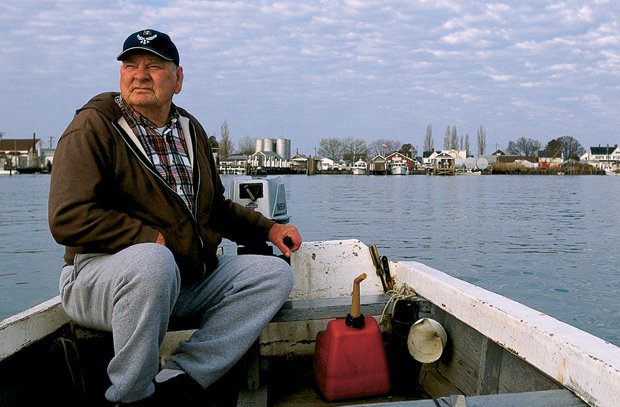
Cade Martin
Wooden boats are still common on Tangier Island.
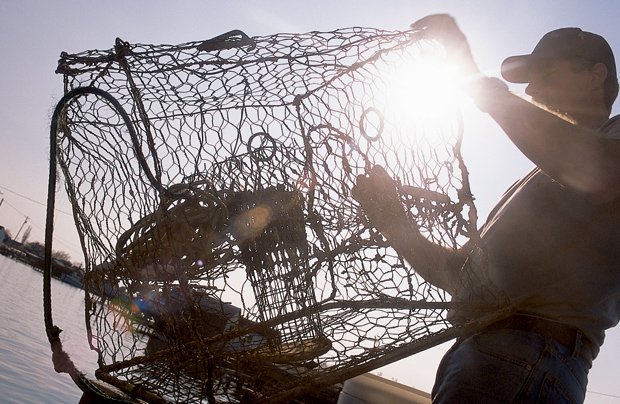
Pier and water
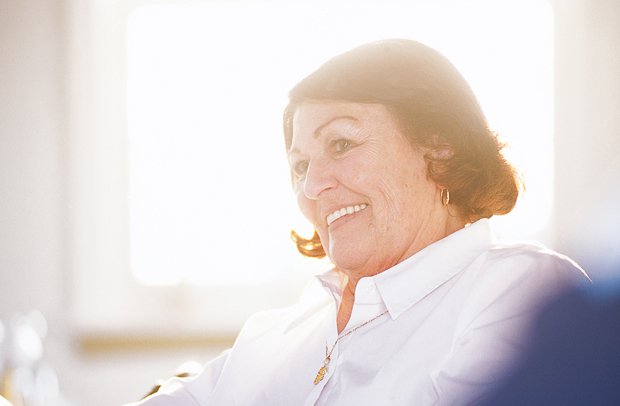
Barbara Thomas at Bay View Inn
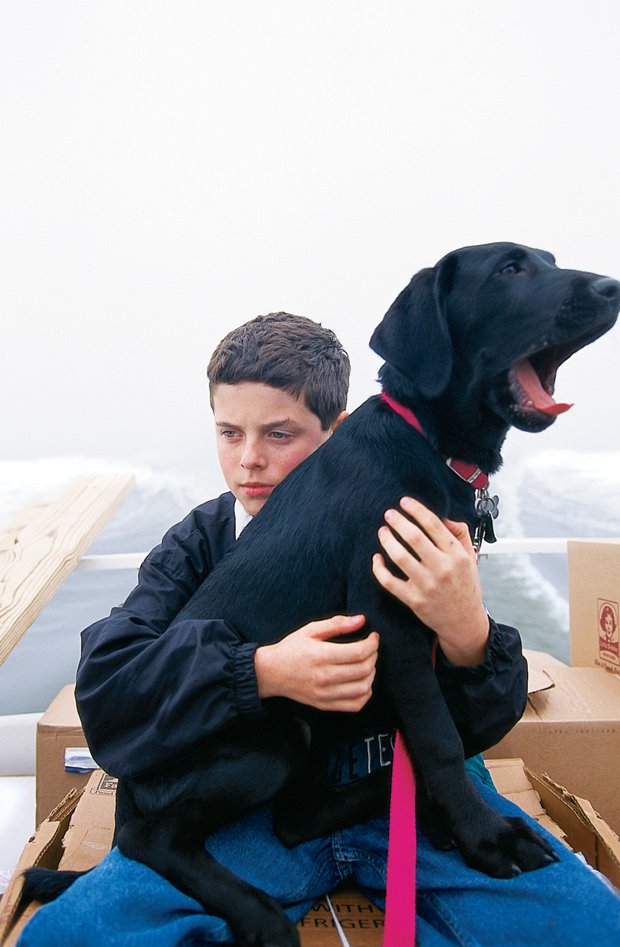
A boy and his Labrador

Juke Marshall on the cover of National Geographic magazine in 1973
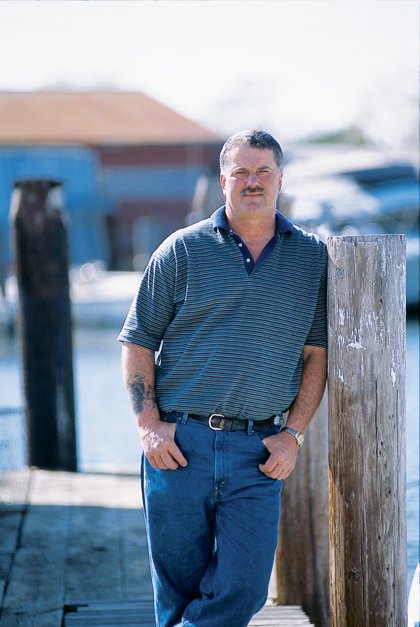
Juke Marshall
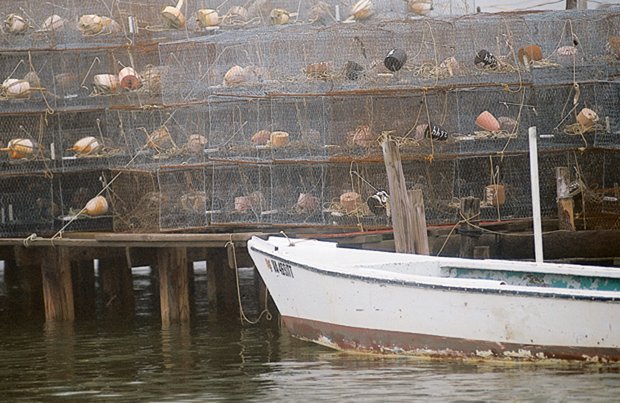
Acres of crab pots
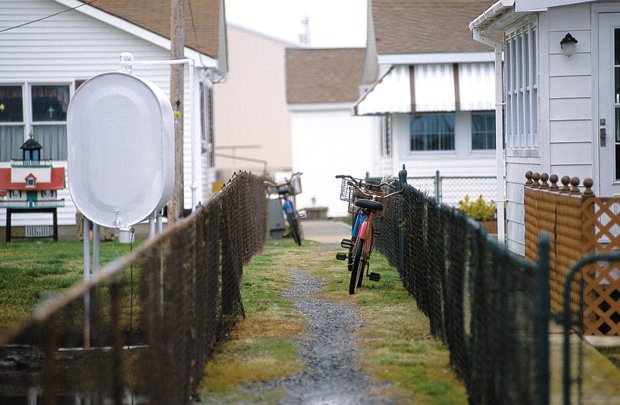
Ubiquitous chain link fences

A wooden bridge

Bikes are primary transportation
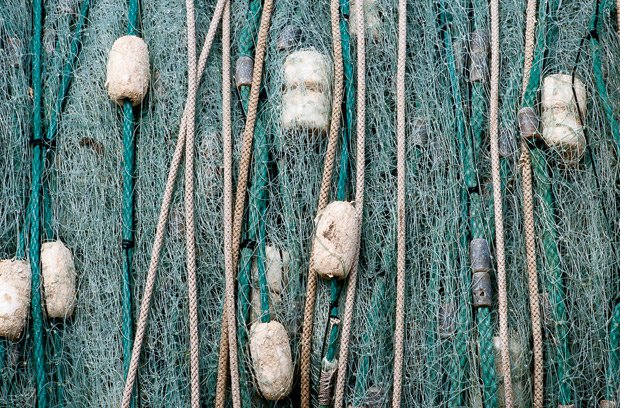
Fishing nets
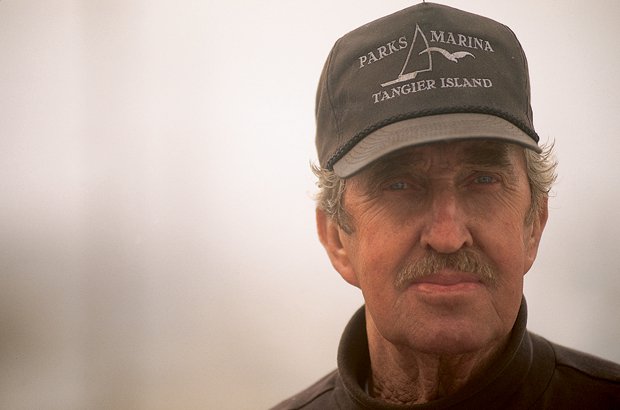
Milton Parks
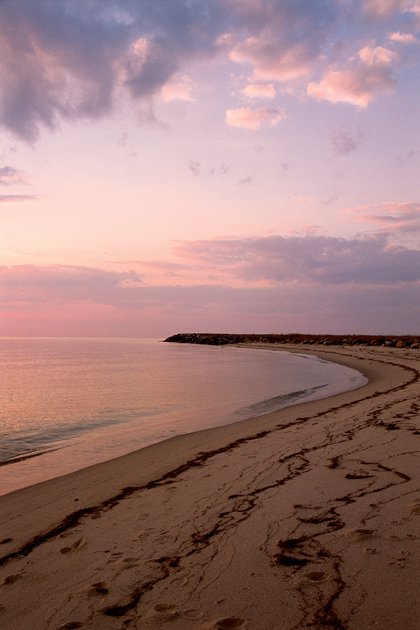
Tangier sunset
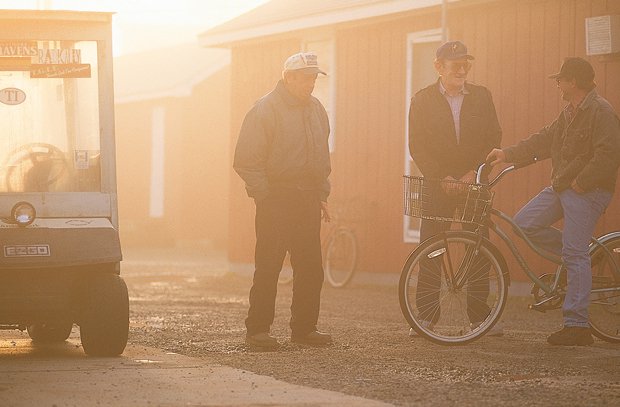
Waiting for the mailboat

An island graveyard
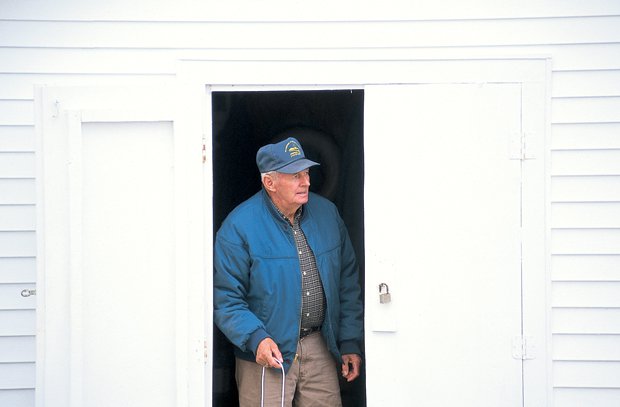
Islander Strickland Crockett
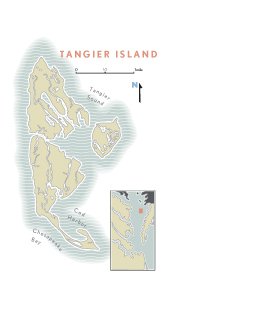
Tangier Island map
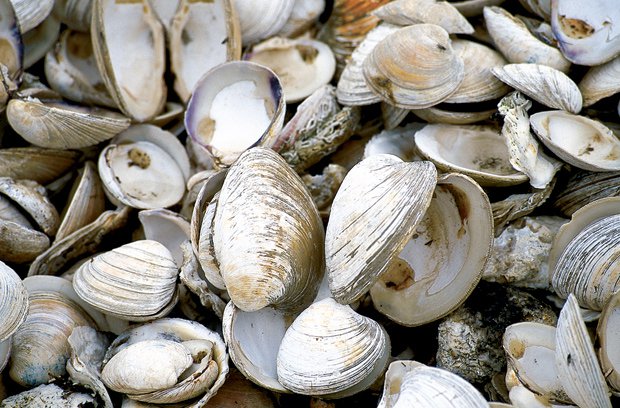
Clam shells at a seafood house

While many enjoy their youth, they often go to the mainland after graduation.
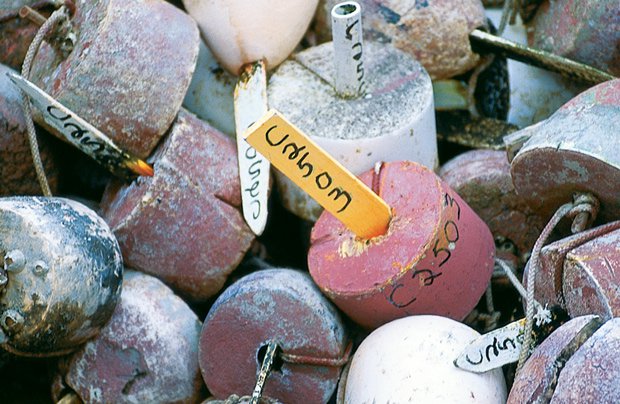
Crab floats
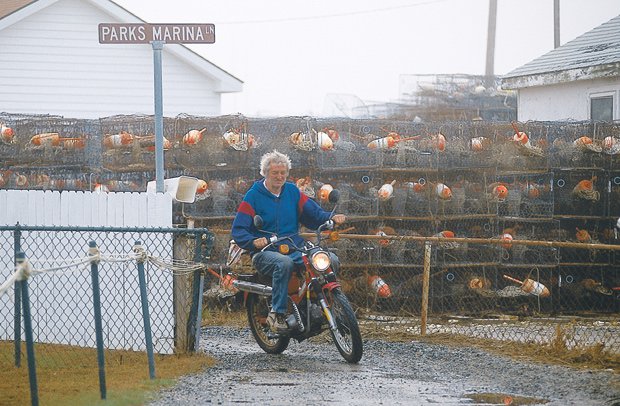
Crab pots are in many a backyard
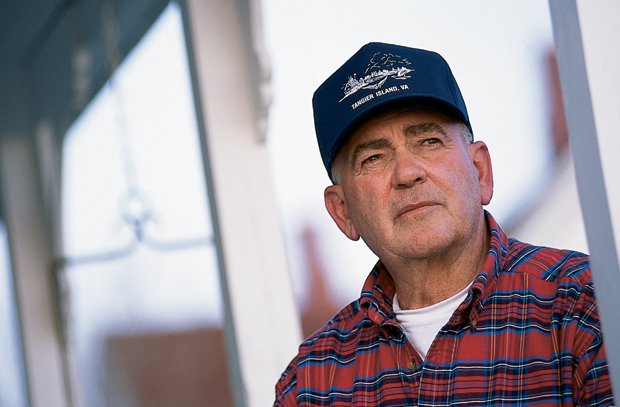
Wallace Pruitt of Shirley's Bay Inn

It started out a simple sleuth’s errand: Find the young Tangier Island boy who in 1973 was immortalized for getting his finger nipped by a blue crab on the cover of National Geographic . The search was similar to the one that National Geographic launched for the “Afghan girl” with sea-green eyes whose 1985 cover shot became a symbol of the plight of refugees. Admittedly, finding a boy from an island fishing community was a little less ambitious. National Geographic ’s investigators had spent several weeks afoot in Afghanistan, peddling the nameless girl’s picture from refugee camp to refugee camp before finally finding someone who recognized her. I had sent an e-mail to island native Bill Pruitt.
“Sure, that’s Juke Marshall,” he said. “Lives in Crisfield. Want his number?”
When John Woodland Crisfield brought the railroad to the sleepy Maryland village of Somers Cove in 1867, it sparked an economic boom so massive that the town simply had to change its name. Situated on the bay side of Maryland’s Eastern Shore, roughly two hours north of Norfolk, Crisfield occupies an enviable perch: nestled between two of the richest oyster and blue crab grounds in the Chesapeake Bay — the Tangier and Pocomoke sounds. It is for this reason that the town of 2,800 souls still receives little challenge to its boast as the “Crab Capital of the World.” But after decades of declining bay health and lackluster harvests, the town is a shadow of its former self.
Crisfield’s other, perhaps less glamorous, claim to fame is being the port of call to the historic fishing village of Tangier Island, which lies just 12 miles off its harbor, across the Tangier Sound. From Crisfield, Tangier receives its mail, its groceries, its prescriptions, its lumber and the bulk of its summer-season tourists. With no industry, no crops, no cattle and no timber to speak of, only what it can wrest from the unpredictable bay, Tangier and its 604 inhabitants depend on Crisfield for just about everything. And for some, that includes a little nip.
“Don’t let ’em tell you they don’t drink,” said Trish, the bartender at the Waterman’s Inn, a local restaurant and watering hole on Crisfield’s main drag. “Yeah, I’ve served most of ‘em.” Tangier, it should be noted, has been dry since its much-storied conversion to Methodism in the early 1800s. This fact, Trish pointed out, only means that the men have to hide their liquor on their boats or slip over to Crisfield undetected.
“They’ll come in off the boat with no bags and drink all weekend. Wearing the same clothes every night,” Trish laughed. “Ah, but they’re really good people. Very religious, though.” Religion is unavoidable when reading about or discussing Tangier. In fact, a number of the island histories I’d read consisted of little more than “had a revival,” “built new church,” “new preacher didn’t suit,” “had a revival,” “added on to church,” “new preacher didn’t suit.” But faith and the island’s religious journey are so integral to an understanding of life on Tangier that to marginalize the importance is to miss the very essence of Tangier. More than their tiny island confines, more than the water on which they eek out a living, the church defines a Tangierman. And yet, it’s what has given this community the bulk of its controversy.
Go as far back as the Civil War when the otherwise proudly Southern islanders sided with the Union, strictly over their religious objection to slavery. Or look more recently to when the island, out of step with the entire Eastern Shore, voted rather convincingly (264 to 71, by the way) against the Virginia Lottery. Faith, very simply, comes first.
In 1998, Tangier town council voted unanimously to reject Warner Brothers’ offer to film the movie Message in a Bottle on the island. The council had held a public hearing to address the matter but reasoned by majority that the “drinking and blasphemy” in the script were simply inconsistent with the image they wanted to portray. “It’s like Children of the Corn over there,” one Warner Brothers location scout commented to a newspaper at the time. “There’s no separation of church and state. It’s grass roots fundamentalism gone totally out of control.”
“There was a lot of bitterness over that,” Trish said. The town of Crisfield lost out as well on what would have been greatly appreciated construction contracts, not to mention the anticipated tourist revenue that generally follows in the wake of being touched by Hollywood. “Five councilmen had no right to decide the fate of all of us.”
The producers of the PG-13 movie eventually settled on New Harbor, Maine, where, according to the governor’s office, it has since brought no less than $15 million to the state’s economy. Tangier received both applause and ridicule for its principled stance, yet it remained unwavering and unapologetic.
“Some people feel hard about it,” said then-mayor Dewey Crockett. “But all of us on the Town Council were voted back in, so I guess most of the islanders agree with us. We would have been glad to have the movie people if they had made the changes in the script we asked. …We didn’t even consider what money we might make from it.”
Juke was late.
“Hey pal, you didn’t tell Juke he had to buy, did ya?” joked a man from across the room. “He’ll never show up!”
The only view I had through the bay window of Joanne’s Country Kitchen was of Route 413 and opposite it the Kingston Construction Company, builders of quality pre-fab poultry houses. I kept an eye out for Juke. Luckily I’d brought along some reading material, articles with titles like “Island Community Desperately Seeks Doctor,” “Dead Body Trapped on Iced-in Island,” “Tangier: Brine-soaked Tradition,” and my favorite, “Church, Crabs, and Television: Three Forces Dominate Life on Tangier.”
I read that Tangier has only a handful of cars and depends primarily on golf carts and bicycles to move about its half square mile of high ground. Children all attend the same school, K through 12, and twice a week a doctor and a dentist visit from the mainland. Most of the women are homemakers, and most of the men crab and/or oyster for a living. Nearly everyone is related and shares one of a handful of surnames that trace back to the island’s settlement in 1778 — names like Crockett, Pruitt, Parks, Thomas, Dise, Shores, Wheatley and Marshall.
Though certainly beset with a unique set of circumstances, Tangier otherwise sounded like the quintessential small town, where everyone knows each other, where the idea of dating is first a matter of ruling out cousins, and where one full-time policeman is more than enough.
Juke eventually emerged from one of the Kingston Construction Co. buildings and came sprinting across the road. A clean-cut stocky man of about 6'2" with short brown hair and a waggish demeanor, Juke apologized for being late.
“I weren’t supposed to have nothing going on,” he said in that lyrical Tangier brogue, “but a guy come over there and I couldn’t get away from him. Time I start walking off ….”
This sort of thing happens when you own the company. “Yeah, I been off the water ’bout eight year now,” he told me. “Come to work up here and I worked up here six years then I bought it … bought the business.”
I looked at the company’s lot through the bay window. If the open warehouse chock full of palleted pre-fab walls was any indication, business was good. It was Saturday and Juke’s morning had started with a business trip to Salisbury at 5 a.m. I asked if six-day workweeks and pre-dawn wakeup calls were the norm.
“Well, I’d always worked on the water, so that’s the way it is on the water.”
There’s something about a waterman’s work ethic that makes you think he’d log 100-hour weeks even if he worked in a bank. Now 42, Juke quite obviously enjoys life as a mainlander, business owner and father of three — he and his wife have two daughters and a son. But he admits there’s something a little strange about it all. “We just bought a farm down the road. I ended up living on the water my whole life and now I’m out in the country. You don’t even see water.”
But could he move back to the island? I asked.
“It’s real nice over there. I tell my wife I could move back if she would,” he said. “But I don’t know if I could. I say I could.”
Juke Marshall moved off the island at 26 to marry his Crisfield sweetheart, and for another nine years he continued to crab, and even did a little conching (fishing for conch shells) in the ocean. But licensing and catch restrictions, coupled with long periods away from home, forced Marshall to reconsider his lifestyle.
“I had kids,” he explained, “and I didn’t want to be away all of the time. When I worked on the water I was away six months of the year, home on weekends. Usually go away in December and come back in May or June. Live right on the boat. It was hard. It’s a hard life. But I loved it. People who do it — they really love it.”
It wasn’t long before Juke sold his gear and accepted a job at his father-in-law’s company, Kingston Construction.
But giving up the water has been hard. Juke and his family still manage to get out on their boat for pleasure, and, not surprisingly, Juke still holds onto a crab shanty in Crisfield, which he leases out. He makes it back to the island about five or six times a year to visit his mother Ruth and his aunts, uncles, cousins and friends. “I’d like to go more,” he regretted, “spend more time, but if you buy a business you gotta be there every day.”
It was nearing noon and I had to catch the 12:30 mail boat to Tangier, so I quickly pulled out my copy of the 1973 National Geographic, just to verify that the boy was in fact Juke. “Yeah, that’s me,” he said somewhat bashfully. “I was 12 years old.” I asked if he remembered NG’s photographer, David Harvey, taking the shot. “Yeah, I was crabbing up on the bridge, catching a crab for him. And I was getting it out of the net … and, you know, that’s what you do as a child over there. My children don’t do it. And I’d like for them to grow up like I grew up but … well, and he got hold of me and bit me right when I was takin’ it out the net.”
It seemed an idyllic image: growing up Tom Sawyer-like, running unleashed with your buddies, progging in the neighborhood streams. You couldn’t help but envy Juke’s memory, and, in my case, wonder if it was still that way on the island. A few of Joanne’s patrons stepped up to the table to have a look at the picture of Juke. A bit chagrined but noticeably proud, he quipped, “All right, it’s a free breakfast if you’re gonna be lookin’.”
On a map, the tiny island of Tangier dangles in the Chesapeake Bay like a fishhook. That’s how the Geographic article described it — though I’d argue it looks like more like a seahorse. Situated mid-bay, about an hour’s boat ride southwest from Crisfield and just eight miles south of the Maryland line, Tangier falls next to last in a diminishing chain of islands that stretches some 30 miles to Maryland’s Bloodsworth Island.
Divided principally into three segments — the Uppards (the seahorse’s head), Tangier proper (the seahorse’s body), and Port Isobel (a piece of food the seahorse is chasing), the island measures at its farthest points roughly two miles long by one mile wide and rises no higher than five feet above mean low tide. The landscape is an amalgam of marsh grass and six habitable “ridges,” crosscut throughout with guts and canals. The roughly 600 souls who call Tangier home live exclusively on the three parallel ridges that occupy Tangier proper, totaling about half a square mile. The Chesapeake Bay Foundation owns and operates a small facility on Port Isobel; and the Uppards, which once supported the community of Canaan, has been uninhabited since 1928.
A quick history of the island is as follows. Though used as a Native American hunting and fishing ground for perhaps 9,000 years, the island, as they say, wasn’t “discovered” until 1608 when Captain John Smith sailed by on a scouting mission from Jamestown and dubbed her (and the 30-mile island chain) the “Russell Iles” — the name “Tangier” wouldn’t appear on maps until 1685. The first settlers, Joseph Crockett and his family, found their way to the island in 1778 — legend (and the state historical marker) says “1686” but it’s just that, legend.
During the American Revolution the island became over-run with Gypsy-like marauders (a.k.a. pirates or “picaroons”), who, as opportunists are want to do, took advantage of the war-time laxity in public policing to pillage the wealthy estates of mainlanders and raid passing ships. Those first settlers, who by 1800 numbered 79, simply endured the occupation and went about their business of farming and raising cattle.
It was in 1805 that, at least for most Tangiermen, the island’s most significant historical event occurred: the Christian conversion of island native Joshua Thomas, the so-called “Parson of the Islands.” By 1808 he had turned the island toward Methodism, which was then a fledgling denomination in America, and in that same year Tangier had its first religious camp meeting.
The War of 1812 brought another occupying force, the British navy. For nearly a year the Brits, who at one point numbered more than 6,000, camped on the island’s southern sand spit, using the strategic mid-bay location as a staging ground for attacks on Washington and later Baltimore’s Fort McHenry. It was on the eve of this last attack that local lay Rev. Joshua Thomas was asked to say a few words to the troops. Thomas took the opportunity to harangue the crowd of armed soldiers, insisting that the Almighty had revealed to him that the British effort to take Baltimore was doomed — a bold statement considering they’d just burned Washington. Nevertheless, he was proven right. From aboard a vessel in the Baltimore harbor, Francis Scott Key recorded the American victory in what became “The Star-Spangled Banner.” Four months later the British withdrew from Tangier, and Joshua Thomas was a celebrity.
Up until the Civil War the islanders had subsisted primarily as farmers but, with Northern seafood stocks greatly depleted and demand still high, the Chesapeake Bay became a hotbed of activity. Islanders soon realized that watering was their future. The oyster industry dominated the scene until the turn of the century, when harvest counts began to drop precipitously. With the sudden decline came a greater interest in fish and crabs. By 1938, with the invention of the crabpot, Tangiermen had found their niche.
The years that followed brought more settlement (by 1930 the population peaked at 1,190), as well as a series of great storms and freezes, and a cholera epidemic that caused a near total evacuation of the island. The “August Storm” of 1933 struck a particularly hard blow, forcing flooded islanders to the top floors of their houses. And, as if to add insult to injury, three years later the “Big Freeze” locked the tiny island in a foot of ice, calling on the Army Air Corps to air-drop food and supplies. By 1928 limited electricity had reached most homes, but island-wide telephones wouldn’t arrive until 1966. Since then the island has gotten an airstrip (1969) and a much needed seawall along the western shore (1990). Today you’d be hard-pressed to find an amenity islanders don’t enjoy. Computers, satellite TV, Internet access, they’ve got ‘em all.
It was getting ridiculous now. The Tangier watermen had just marched down Janders Road, armed with a ridiculous assortment of weapons — wooden oars and oyster tongs — intent on taking the visiting dentist hostage. The plan was to force the governor to remove the speed-check lines he’d ordered painted on the town’s cart-width streets. And while they were at it, there was talk of seceding from Virginia.
I hadn’t even made it off the mailboat to Tangier and already my book, Patricia Cornwell’s Isle of Dogs , had put me at risk of getting pummeled by a local. I quickly hid it. Poor Tangier. The island’s insularity seems to invite crazed flights of fancy from landlubbers. Cornwell’s treatment, though absurd and at times downright insulting, is something Tangiermen have had to live with for years: visitors mocking their “peculiar” accent and their intense faith, as well as their habit (by no means unique to Tangier) of burying relatives in the front yard.
My seatmate, eager to author another rumor, had this to say: “I hear Tangierians [his word] have the highest rate of cholesterol of any community in the United States.” And, whispering, “I understand it’s because of the inbreeding.”
A common attack on Tangiermen. And flatly unjustified. It’s true that in the 1950s researchers from around the world came to investigate Tangier as a case study in “closed communities.” In fact, their research yielded a disease known as “Tangier Disease,” an inherited blood disorder. The disease, it’s believed, is the result of genetic isolation, or the Founder’s effect — where in an isolated community an early ancestor passes a particular gene down the bloodline. It’s not meant to suggest that anyone’s marrying his sister. Admittedly, and quite unavoidably, cousins do marry on Tangier, but rarely if ever does it get closer than a second cousin.
As the boat approached the island, I expected somewhat of an island mound. Instead, it looked like a giant sandbar. The cluster of white buildings seemed to float atop the surface of the water like a village of ice-fishing huts. A closer inspection revealed that some, in fact, do sit atop the water — lining the harbor are the watermen’s stilted crab shanties, used during the crab molting season to cull out ready-for-market peelers. Still, looking to the shore, the island’s mere five feet of water clearance seemed apparent. Only the church steeple and the water tower appeared safe.
I had come to Tangier in the off-season, that silent and welcomed gap from October to April — the on-season being the rest of the year, when some 20,000 tourists descend on the island. The pleasures of the off-season are obvious: less crowded streets and less edgy locals. (You’d be edgy too if over-anxious, map-clutching tourists wanted to photograph you taking out the trash.)
At the dock standing next to his impressive six-seater golf cart was my host, Wallace Pruitt, the wonderfully gregarious operator of Shirley’s Bay View Inn.
“Welcome to d’aye-land,” Wallace said, in an accent that immediately sounded foreign. Some say that due to years of isolation the Tangier accent remains a vestige of the original West Country dialect spoken by the island’s original Cornish settlers — and perhaps the closest example we have to how Shakespeare would have spoken. Not so, says linguist David Shores, author of Tangier Island: Place, People, and Talk. “It’s simply one of the many American regional dialects. It’s rather distinctive, but it’s definitely not Elizabethan.”
With Wallace’s directions, I first headed toward the sand spit at the southern end of the island, where Joshua Thomas gave his famous speech to the occupying British soldiers, and where for years the island had its camp meetings, bringing in sometimes as many as 10,000 faithful from the mainland and neighboring islands. Just after the bridge that accesses the beach, and only feet from the bay, were the remains of an old house: a few brick pillars and some charred wood amidst sand and sea grass. I’d come to learn this home once belonged to the Jander family. While on vacation here in the 1930s, Henry and Anne Jander fell in love with the island and its inhabitants. In short order they settled their affairs back home in Connecticut and moved their family to the then-vacant and dilapidated house at the remote southwest end of the island. The family’s delightful story of assimilation is recounted in Anne Jander’s memoir, Crab’s Hole , written during her 10-year stay and only recently published by her children.
Leaving the island’s “West Ridge,” I headed across the “Big Gut” to the “Main Ridge,” where the church, the school, the fire station, the few stores and the majority of the homes are found. The houses on Tangier are rather non-descript, generally white and unadorned. Some are more weathered than others, but the community is largely classless. There’s an obvious progression to remodeling, starting with the original clapboards and moving on to asbestos shingles and more recently vinyl. The picket fences that once lined all of the town’s streets, giving it that Mayberry RFD -feel, are gradually coming back, replacing the chainlink fence craze of the last 30 years. The yards are small and often backed with rows of ready-to-toss crabpots. Fewer houses than I’d imagined had tombstones in their yards. Most graves were relegated to the cemeteries scattered about the island.
I followed closely the walking tour in Kirk Mariner’s book, God’s Island , which provides some juicy trivia — the Methodist parsonage apparently started the chain link craze — as well as some surprising sites, like the building where Tangier’s only unsolved murder occurred.
Seventeen-year-old Roland Parks was out one Sunday morning in the 1930s getting some ice cream for his invalid mother from his family’s store. The store, of course, was closed, it being Sunday. Deputy sheriff “Bud” Connorton approached and insisted that Parks turn around and go home, seeing as the town ordinance forbade “loafing on store porches and streets on Sunday.” Not persuaded, Parks retrieved his ice cream and went home. Connorton followed. Standing at his front door, Parks turned to face Connorton — some say taunting him — and the deputy sheriff summarily unloaded a round in his chest. Parks, it turns out, survived the gunshot wound. But a year later, after having returned from jail and resumed his post as deputy sheriff, Connorton was shot through a window by an unknown assailant. Curiously, the site is now an ice cream shop.
After touring the island a few dozen times, I headed to Lorraine’s for dinner — Lorraine’s, by the way, is your only dining option in the off-season. Expecting it to be crowded, I found only the Erickson family, a lovely couple from Nebraska who, with their twin daughters, were staying at the Bay View Inn with me. I soon learned that everyone on the island was at the volleyball tournament in the recreation center. After eating, I’d head over to watch.
The two ladies working the counter at Lorraine’s took a break to sit and talk with us. Their appreciation for the island’s pace in the off-season was apparent. The tourist season, they said, tends to run them ragged, but they enjoy the visitors. They admitted that the island life isn’t entirely idyllic, that Tangier has problems (drugs, drinking, etc.) like anyplace, but on the whole the people are all good and loving and watch out for each other.
“I’m just contented here,” one woman said. “Which I don’t guess I’m normal — a lot of people from here likes to go away. They like to go to Wal-Mart and shoppin’, you know, to the grocery store. But I’m just contented.” They explained how the scarcity of crabbing permits has driven a number of the young people off the island, either to college or in search of work. Those intent on staying on the island have found an option in running tugboats, mostly out of Norfolk. While the job security and benefits are attractive, the time away from home can be hard on the family. For some, though, it’s better than leaving for good.
As I paid my bill, two teenagers walked in, mid-conversation. They looked like they could have been from any town in America: she in a college sweatshirt, he in a Dale Earnhart jersey.
“You gonna go to the revival tomorrow night?” he asked, averting his eyes to the floor.
“Yeah, probably,” she replied matter-of-factly.
“Wanna go with me?”
I wondered if any TV viewer would have bought this piece of dialogue.
The charge for the volleyball match was $2, not bad for an evening’s entertainment, I thought. Inside it was packed. The interior, just like the exterior, was no-frills, with blank walls and a vinyl-tiled floor with five-row bleacher seating to one side and a single line of folding chairs along the other. A card table sat in the corner with napkins and condiments for your hot dogs — occasionally it was hit by an errant volleyball. There seemed to be no order to the games; a mismatched group would step up and play and then fade back into the crowd. A lady sat at the net keeping score with flip cards. Though a few watched intently, most talked amongst themselves, strangely as if relishing a rare opportunity to see one another. Dangerously beautiful young girls primped and giggled on the bleachers, and younger kids ran wild. The tiniest of children crawled about the floors unattended, mothers and daughters sharing the responsibility of watching over whoever’s child crawled by. It felt like a family reunion.
Back at the Bay View Inn, I relaxed awhile on Wallace’s backyard observation deck, listening to the bay in the distance as it gnawed away at the shore. Looking west, I could see the distant lights of Reedville and east, the yellow squares of the town. A skim of water blanketed Wallace’s yard and glistened in the moonlight.
The island seemed so vulnerable, battling tides and youth migration and television and tourists. Still, something seemed immutable, something anchored in the community’s tremendous sense of faith and family. Tangier, I thought, may go the way of islands like Shanks and Fox and Little Watts, sinking beneath the always moving bay. But my mind’s eye also saw a dozen old watermen and their sons, boats encircled atop Tangier’s ghostly outline, sharing a story or two about the old days of progging in her marsh streams and courting at the revivals. And, sure, they were complaining about the catch.
This article originally appeared in our June 2003 issue.

A Powerful Influence: Early Photographs of African Americans from the Collection of Dennis O. Williams
Apr 4, 2024
Virginia Museum of Fine Arts
Group Exhibition: Spiraling
Reynolds Gallery
Ukelele Orchestra of Great Britain
Moss Arts Center
Most Popular

Checkerboard is Back
But now it has multiple personalities. Read more
House + Garden

The Lowdown on Ultra-Processed Foods
Research shows healthier options are best. Read more
Health+Wellness

Courtesy of Camp Friendship
Fireflies & Friendships
Sleepaway camps let kids be kids. Read more
© 2016-2020 Cape Fear Publishing Co. Inc.
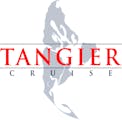
Tangier Island Cruise
Quick Details
- Hour Glass Duration: 6 hours
- Users Ages: All ages
Phone Groups of 25+: Please call 804-453-2628
Cruise Through Beautiful Chesapeake Bay on This Scenic Island Journey
Visit the remote Tangier Island in the middle of the Chesapeake Bay for a day of family fun! The island is in Virginia waters and is part of Accomack County. Your cruise leaves from Historic Reedville, VA, the center of the largest fishing industry in the United States. Our ship, the Chesapeake Breeze, is comfortable, and the views from the upper deck can’t be beaten.
The ship often passes fishing boats working their nets or large ocean freighters traveling between Baltimore and Norfolk or points beyond. You also see Tangier Island watermen making their living on the bay. Walk around this quaint island or take a tour on a mini-bus. Either way, you are sure to remember your trip to Tangier Island for a long time to come.
- Depart Reedville at 10 a.m.
- Arrive Tangier at 11:30 a.m.
- Depart Tangier at 2:15 p.m.
- Arrive Reedville at 4:15 p.m.
Local Restaurants
Whether you’re craving crab cakes or a soft-shelled crab sandwich, Tangier Island has some of the freshest seafood from the Chesapeake Bay.
- Lorraine’s Snack Bar
- Four Brother’s Crab House
- Muddy Toes Cafe
Tangier Island Accommodations
Spend a night or the whole weekend away from the city. Enjoy the peace and quiet of Tangier Island nights and make the most of your time away from home.
- Brigadune Beachside Getaway
- Chevron down Cancellation Policy
Customers receive a full refund with 24 hours’ notice of cancellation. Customers also receive a full refund in case of operator cancellation due to weather or other unforeseen circumstances. Contact us by phone to cancel or inquire about a cancellation. No-shows are charged the full price.

- Children’s Health
- Women’s Health
- Men’s Health
- Senior Health
- Mental Health
- RVA Family Fun
- Food & Recipes
- Home & Garden
- Publisher’s Page
- Richmond History
- Nonprofit Spotlight
- News & Press
- Featured Folks
- Parenting Tips
- Civics & Policy
- Family Finances
- Legal Advice
- Safety Tips
- Books & Authors
- Museums & Exhibits
- Theatre & Performance
- Arts & Crafts
- Science & Technology
- Summer Camp Finder
- Party Finder
- Private School Finder
- Preschool Finder
- Browse By Date
- Calendar Events Map
- Submit Your Event
Explore More
- About Our Magazine
- RFM Summer Camp Expo
- RFM Education Expo
- Find a Local Copy
- View Issue Archives
- Advertising & Media Kit
- Content Submission Guide

Visit Tangier, Virginia’s Endangered Island
In 2015, National Geographic magazine identified Tangier Island, Virginia, as one of its twenty must-see places in the world. The tiny island shared the list with exotic destinations, such as Okavango Delta in Botswana and Eastern Bhutan in the Himalayas. Reading the article, I was surprised I’d overlooked an adventure so close by. Located less than two hours from Richmond in the middle of the Chesapeake Bay, the town of Tangier on Tangier Island has long been known for its blue crab, but recently it has gained attention because it is projected to be among the first North American locations lost to climate change.
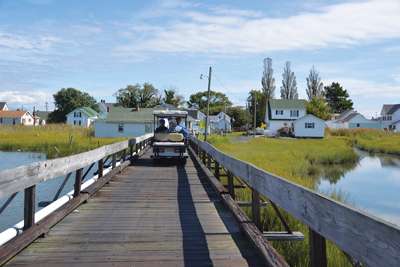
Tangier Island is the only inhabited island on Virginia’s coast that’s not connected to the mainland by a bridge. The closest ferry departs Reedville, Virginia, daily, May through October. Marsh comprises over two-thirds of the 5-mile island, so it was recommended we avoid peak summer months when mosquitoes are a nuisance. I penciled the trip onto the family calendar six times before the weather cooperated. Then, finally, one Saturday morning in late September, my teenage daughters and I traveled to the coast.
The drive to the Northern Neck is picturesque. As we passed fog-covered farm stands, the remoteness of our destination began to sink in. It’s eighteen miles by boat from Buzzard’s Point Marina in Reedville to Tangier Island, and the Chesapeake Breeze took an hour and thirty minutes to travel the distance. Since it was a gorgeous day to be on the Chesapeake Bay, we selected a bench on the bow. Sunny and seventy, our patience had paid off.
Tangier Island came into view about halfway through the trip. Like a hazy mirage, the land mass was so small initially that I doubted it could be our destination. Water penetrated the island in different places along the horizon so it looked like a puzzle with missing pieces. Eventually, the Tangier Island water tower became identifiable.
As we approached the harbor, the captain of the Breeze pointed out the breaking wall of carefully arranged oversized rocks along the western rim. He explained how Tangier residents hope a similar barrier can be placed on the eastern side of the island to prevent further erosion. This comment and the mention of erosion prompted some teenagers on a field trip to begin discussing climate change. I was pleased to hear them recount the complex factors impacting this endangered environment. With Tangier Island sitting only a few feet above the water, the reality is a barrier wall is no match for the rising sea level.
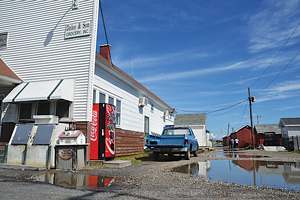
The harbor boasted a miniature floating city of free-standing docks peppered with weathered wooden sheds and stacks of crab pots. Motorized boats crisscrossed the channel between a few soft-shell crab shedding facilities. Dangling electrical wires connected the crab shacks, the way strings linked the plastic cups I used when playing telephone as a child. Gulls rested on wood pilings, where planks had already collapsed into the sea and lines of posts were the only evidence of previous walking paths.
Houses crowded the shoreline the way one might expect in any fishing town. The difference is overturned boats and abandoned structures are interspersed with well-maintained homes with white picket fences. At one point, there were as many as 1,500 people living on the island, but with each passing storm, more and more residents desert their damaged houses, instead of repairing them. When my 16-year-old heard that approximately four hundred people live on the island now, she was astonished. “There are more kids in my high school!”
This means when a seasonal ferry like ours from Virginia docks next to the year-round cruise boat from Maryland, the Steven Thomas , the island’s population nearly doubles when all the passengers debark.
We followed the rusted chain-link fence past the welcome sign, declaring Tangier residents the “farmers of the Chesapeake.” Local women waited there with their golf carts. Interested visitors can enjoy a 20-minute tour of the island for the cost of $5 per person. I’d been reading Chesapeake Requiem: A Year with the Watermen of the Vanishing Tangier Island by Earl Swift, so I knew about the residents’ distinct dialect and wanted to hear it first-hand, so we jumped in a golf cart.
Born and raised in Tangier, our guide, Sylvia, spoke with the remnants of an accent inherited from British ancestors and preserved by the island’s isolation. She explained how John Smith visited in 1608 and how it’s believed the island was named after Native American pottery, called tangle, found in the area. Sylvia also shared how, according to legend, in 1686, John Crockett and his sons’ families settled on the island, purchasing it for two overcoats from the Pocomoke Indians, who spent their summer on the island.
Since less than one square mile of island is livable, houses are close together. In many cases, homes are only separated by walkways large enough to hold fuel tanks. Car traffic is limited to only a handful of vehicles, so people often navigate the tight spaces on scooters.
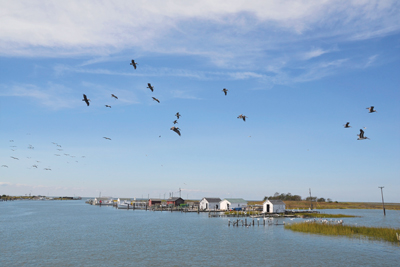
Sylvia explained the logistics of a life lived in isolation. A boat with mail from Maryland, thirteen miles across the Chesapeake Bay, arrives weekdays at 1:15 p.m. Each family must go to the post office to pick it up. A nurse practitioner resides on the island, working out of the David B. Nichols Health Center, and a doctor visits the island one day a week. In the event of a medical emergency, there’s a helicopter on call in Maryland, which can be there in twenty minutes.
We crossed the marsh on a small wooden bridge – big enough for one golf cart – to the West Ridge. From this vantage point, the tall grasses blocked from view all but the rooftops on the Main Ridge. Water has always divided the island from Main Ridge to Hog Ridge, but by 2019, most of the West Ridge is covered by the Chesapeake Bay.
From the golf cart, Sylvia pointed out the island’s school on the north end of the marsh. The large, single-story white building, next to the water tower, accommodates all grades, including fifty-five students and their fourteen teachers. In 2018, there were six graduates. Sylvia explained nearly the entire island attended the ceremony because, in a community this small, it feels like everyone has had a hand in raising the young people. Since I am a teacher, I would have liked to get a better look at the facility, but the School Road bridge was closed because its integrity had been compromised. I struggled to imagine how unsettling it must be to live someplace that’s crumbling into the sea, like a sand castle into the surf.
When our tour ended just before noon, we decided to catch an early lunch at the Fisherman’s Corner Restaurant. An exterior sign advertised how it had been featured in Southern Living magazine. With only two sit-down restaurants near the dock open this time of year, there was a bit of a wait, but the crab cakes were definitely worth it. I’ll admit when my plate arrived at our table, without any fixings I had my doubts, but the crab was so fresh and the sandwich so moist that I decided lettuce and tomato would have just been a distraction.
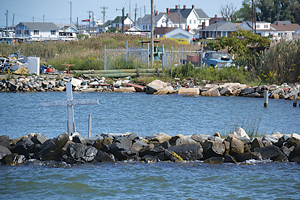
Afterwards, we walked south on Main Ridge towards the Tangier History Museum and Interpretive Cultural Center. For only $3, visitors can enjoy a video and view artifacts, as well as a 5-tier model of Tangier Island’s decreasing size. On the street outside, my older daughter stopped to photograph a reverse water osmosis tank, having learned about the salt-water filtration system that converts seawater to drinking water. Then, we continued on our self-guided walking history tour along the road. Pictorial displays detail hundreds of places relevant to the island life, such as the Double Six Sandwich Shop, where watermen meet at three in the morning before heading off to work on the Chesapeake.
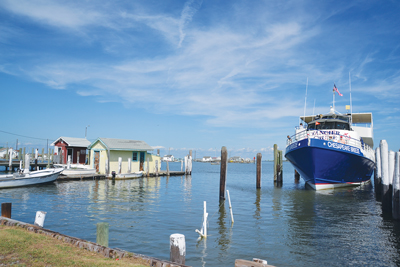
While we wandered around, my children and I discussed an uneasiness that hangs in the sea air. Having run out of land, family members are buried in yards and their gravesites are covered with concrete lids to prevent caskets from floating away during floods. Water filled the streets, forcing us to take circuitous routes, and fences surrounded yards to prevent pets and children from the threat of drowning. The islanders’ harsh reality was a lot to take in, but I am so glad we made the trip.
Originally, we wondered how we would spend the two and a half hours on such a tiny piece of land, but our time on Tangier Island passed quickly. My daughters meandered through the gift shops and lingered at the ice cream stand. We never made it to the beach, but that hadn’t been our intent. This trip was about bearing witness to an endangered lifestyle. When my 12-year-old remarked, “We did this to ourselves,” I took solace in her use of the pronoun we . At a young age, she recognizes that the catastrophes caused by climate change are our problem – not just theirs. This acknowledgement is the first step in saving us all.

Victoria Winterhalter is a mother, teacher, reader, and writer on the education and environment beats for RFM. She has been with RFM since its founding in 2009 and has contributed photos and written numerous articles on education, parenting, and family travel.

Explore, Rejuvenate, and Learn at Pocahontas State Park
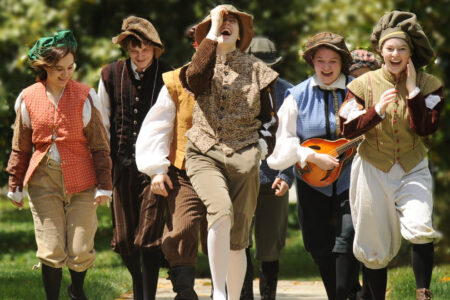
Agecroft Hall and Gardens Celebrates 460th Birthday of William Shakespeare

Safety First! Viewing Reminders for April 8 Solar Eclipse

- Submissions
- View Calendar
- Events by Location
- Come See Us Events
- Education Expo
- Summer Camp Expo
Directories
- Summer Camps
- Private Schools
Let's Keep Connected
Subscribe to our free newsletter to receive the latest content, events, and giveaway entry notifications.
- Privacy Policy
- Terms of Use
Type above and press Enter to search. Press Esc to cancel.

There are reasons over 18,000 families have signed up for the RFM eNews.

The Cornish Bird
Cornwall's Hidden History Blog
Tangier Island, Virginia – a forgotten community founded by Cornish fishermen

Tangier Island is a wild, marshy landmass in Chesapeake Bay, Virginia on the east coast of America. The tiny population of around 500 people survives mainly on fishing, harvesting crabs and oysters and, in recent years, tourism.
It is a remote, isolated community, cut off from the mainland for centuries. The islanders have developed their own culture and way of living, yet bizarrely this unlikely place is also deeply connected to Cornwall.

The inhabitants of Tangier Island are said to talk with a strange American-Cornish accent and the St Piran’s cross even graces their island’s flag. So, how did this unusual connection come about?
It is all because the first permanent colonial settlement on the island was founded by Cornish farmers and fishermen back in the 17th century.
An Isolated Idyll
Separated from the mainland by a deep channel 12 miles wide Tangier Island is only accessible by seaplane or boat. Covering only 1.5 square miles it is truly tiny place that unfortunately it is shrinking by the day.
The people here hold fast to a very quiet and traditional way of living and up until fairly recently daily life was governed by strict Methodist beliefs. There are almost no cars, most people get about by bicycle, motorbike or boat; there is no alcohol, no mobile phone reception, no police and, the locals say, no reason to lock your doors.

The Cornish Settlers of Tangier Island
For thousands of years, up until the early 17th century, Tangier had been used as retreat by the local Pokomoke Indians whose arrowheads can still be found in their hundreds across the island. Although the English explorer John Smith first visited here in 1608 but it took a further 78 years before there was a permanent settlement on Tangier Island.
“Tangier is an island of fishermen. The people earn their living from the water – oystering, crabbing and fishing. They are descendants of John Crockett and others from Cornwall who settled on Tangier Island in 1686.” Coventry Evening Telegraph, 6 November 1961
In 1686 five (or seven or fourteen depending on what you read) Cornish families moved to Tangier Island and made it their home.
They were said to be farmers and fishermen, possibly from the Padstow area, well suited to the rigours of making a life for themselves and their families in the New World.

It is thought that John Crockett and his wife, with their four sons and four daughters, were amongst the first settlers, along with other families who names we aren’t quite so sure of. Together they built houses, they intermarried and had more children, they made a life for themselves far away from the Cornish shores they had left behind. Though, as you might expect, it was not always easy as this cutting from 1936 proves.

Today it is believed that by and large all of the islanders are descended from those few original families. The community nearly all have the same few surnames Crockett, Pruitt, Thomas, Marshall, Charnock, Dise, Shores and Parks.
In 1940 Lieutenant William J. Trevorrow, a Cornish Bard from California, visited the island and wrote to The Cornishman newspaper about his visit:
“I visited Tangier Island, sixty miles up the Chesapeake Bay, Virginia, where in 1686 Cornish fishermen settled . . . They number 1,400 people . . .a sober-minded, superior people who are considered by other Viriginians to have retained old customs, more so than other colonial settlers.”
This holding on to tradition is perhaps the most fascinating aspect of life on Tangier Island.
Americans with a Cornish Accent?
Even today other Americans visiting the island say that it is like stepping back in time and perhaps one of the most distinctive things they notice is the strange accent of the islanders.
Some say that it is the remnants of “Elizabethan English” but most agree that the geographical isolation and strict adherence to tradition has created a truly unique speech pattern that is believed to have been passed down from the original Cornish settlers.
One islander, David Shores, has written a book about the history of his home and he confirms that their dialect is believed to have descended from those original families from Cornwall. Due to their lack of any contact with the outside world it has remained largely intact, though of course they have added to and adapted the language as any closed community would.
“Tangier was founded in the late 1600s by settlers who were actually Cornish so we see some influence there. And because of the remoteness the residents who lived there were really in linguistic isolation from the mainland.” Christine Mallison, Assistant Professor, Language, Literacy & Culture, University of Maryland, baltimore

You can listen yourself below and see what you think. Does it sound like Cornish dialect to you?
It might be wishful thinking on my behalf, but I think I can recognise a familiar tone or accent there, and even some of the faces seem familiar to me too . . .
Going, Going, Gone – The disappearing Island
Sadly a combination of erosion and rising sea levels means that Tangier Island is literally sinking.
The New York Times recently reported that the island’s landmass has already shrunk by two-thirds since 1850 and with its highest point just 4ft above sea level some scientists fear that the islanders will need to find somewhere else to live by as early as 2037.
A sea wall has been proposed to protect the island from the ever-encroaching sea but the huge cost of such a project means that the islanders are struggling to get any support from the state authorities or government.
Much of the population has already started to leave, at its peak the island was home to around 2000 people these days that has dwindled to around 400 – 500 as year on year more people leave in search of work and an easier life.
It is a story that we in Cornwall can recognise all too well.
The tragedy is that this precious, unique community, that has survived for more than 300 years since those first Cornish settlers arrived, may not be there much longer.
Final Thoughts
I never knew a thing about this community before I began my research and I have to say I was astonished and delighted by the connection. It is wonderful to find us Cornish reaching out and stretching ourselves across the globe, proving once more that we have never been truly confined to this granite peninsula although it is, of course, where our heart lies.
I tried to make contact with the tiny museum on Tangier Island, I had so many questions, but as yet have had no response to my letter (there is no email available) which I sent back in August. But if I do hear anything I will be sure to update you here!
I must acknowledge that the inspiration for this post comes from a lovely reader who emailed me a few months ago after meeting someone from Tangier Island and wrote to tell me about it!
Further Reading
The Murder of Billy Kinsman – Cornishman shot dead in Tombstone
Death in Arizona – how a Cornish miner came to die in the desert
Charles Carkeet James – Cornish Quaker & Innovator in India
Share this:
9 thoughts on “ tangier island, virginia – a forgotten community founded by cornish fishermen ”.
Fascinating read. I love quirks like this. Great research.
Thanks for this article! We used to sail in the Chesapeake a lot every summer and I’ve always been fascinated by the “archaic Elizabethan” accent of Tangier Island. It just seems right to learn that the settlers were from Cornwall.
It is a strange combination of American accent and Cornish!
That was such a treat to find. I looked up Tangier as we are planning to go to Morocco at Christmas and came across Tangier Island. Two minutes later you popped up with this research. Wow! Love your posts. Thank you? Jan x
I was born in Cornwall & several years ago I visited Tangier Island as a mariner, & was astounded when one of the inhabitants, after hearing me say a few words said ‘ You’re one of us aren’t you?
Hi there, although not Cornish, I have spent quite a lot of time in this beautiful county & can definitely hear a Cornish ‘lilt’ in the voices of the folk on this little island. Thank you for sharing. Caz
Thank you for all your hard work. Unforyunately at present, my outgoings exceed my income, but will describe when things improve; trust you will understand.
I live on the mainland in Maryland, and there is a daily boat taking visitors to Tangier Island every morning. If you visit the Washington DC or Baltimore area, drive over the Bay Bridge from Annapolis, and head south to Crisfield, Maryland. That’s where you’ll find the boat. There is a beautiful church on the island, gift shops, a restaurant, an ice cream shop, and some lodging for tourists. Tourists can rent a golf cart and drive around the island, visit the white sand beaches, dine on local delicacies, and learn about the wonderful culture and history of the people who live there. A few miles to the north, there is Smith Island in the Maryland portion of Chesapeake Bay. Smith shares the same culture and history with Tangier. If you like to visit other countries, but you don’t want to go to the typical tourist traps, this is a great option.
- Pingback: The Murder of Billy Kinsman - Cornishman shot dead in Tombstone - The Cornish Bird
Leave a Reply Cancel reply

Discover more from The Cornish Bird
Subscribe now to keep reading and get access to the full archive.
Type your email…
Continue reading

- Plan Your Trip
- Travel Guide

Welcome to the Eastern Shore of Virginia
Relax- that’s not hard when you land on the longest stretch of wild coastline remaining on the entire East Coast. Located a short distance from major cities, the Eastern Shore is home to the car-less Tangier Island, 14 undeveloped seaside barrier islands, an award-winning winery, and historic waterfront towns like charming Cape Charles and Onancock. We’re a BLAST – literally! Rocket launches soar over our skies not far from our wild Chincoteague Ponies, thanks to the Mid-Atlantic Regional Spaceport and NASA. Our thriving artisan’s community and authentic coastal heritage make us unique. Experience our history and see watermen tilling tides and visit family farms on both bayside and seaside. We think you’ll like it here.

- Apr 05 Women’s Wellness Weekend , Cape Charles
- Apr 19 Virginia Victorious: The Eastern Shore and the War of 1812 , Onancock
- Apr 20 Return to Our Roots , Exmore
- May 02 America’s First First Lady Visits Onancock , Onancock
- May 04 Chincoteague Seafood Festival , Chincoteague
- May 04 Peninsula Tractor Organization Antique Tractor Show , Nassawaddox
- May 04 Field Day Fiesta , Onancock
- May 10 Book Signing & Lecture with Philip Bigler , Onancock
- Jul 24 99th Annual Chincoteague Pony Swim , Chincoteague
- Jul 25 99th Annual Pony Auction , Chincoteague

Find unique experiences on Virginia’s Natural Coast

View All Experiences
Start planning your adventure to Virginia’s Eastern Shore. From railroad towns to waterfront paradises where wild ponies roam to beachfront escapes and sunsets over the wharf, you’ve got so much to discover. Explore our towns with this map!
Get live traffic updates on the CBBT
Our email newsletters feature helpful information, upcoming events and attractions throughout the Eastern Shore of Virginia. Whether you’re planning your trip or staying in the know, our newsletters will keep you informed.
Accomac | Cape Charles | Chincoteague | Exmore | Onancock | Onley | Parksley | Saxis | Tangier Island | Wachapreague

IMAGES
VIDEO
COMMENTS
Visit the historic Tangier Island located on the Chesapeake Bay where Tangiermen share the beauty of their island and the great Chesapeake Bay with others.The Tangier Island Guide includes accommodations and lodging, bed and breakfasts, restaurants, transportation, marina, airport, and other information as well as the history of Tangier Island.
As Tangier is an island located about 15 miles off the Eastern Shore, the only way to access it is by boating (or flying) across the Chesapeake Bay. The first step in your journey to Tangier is to cross the Chesapeake Bay. The Island can be accessed by boat or by plane. A popular way to get there is by taking the Tangier Ferry, which leaves out ...
Tangier Island is often referred to as the 'soft shell crab capital of the world' and is a unique place to visit. Located on the Chesapeake Bay in Virginia, Tangier is made up of many small islands divided by marshes and small tidal streams. It is located 12 miles off of the mainland and is only accessible by boat or airplane.
19056 Parkway. Melfa, VA 23410. Phone: (757) 787-8268. Tangier is a remote island accessible by air or sea, 12 miles out in the Chesapeake Bay. Visit the "soft crab capital" of the nation and feel welcome by the locals who take much pride in their lifestyle. See the narrow streets, traveled mostly by bicycles and golf carts, the unspoiled ...
Orient yourself with a map of Tangier Island. Visit the Tangier History Museum & Interpretive Cultural Center. It is located at 16215 Main Ridge, just south of Spanky's Ice Cream Parlor on the East side of the road. Consider paddling through the Tangier Island water trails. Tangier Island offers a unique opportunity to explore the marshes ...
Things to Do in Tangier Island, Virginia: See Tripadvisor's 814 traveler reviews and photos of Tangier Island tourist attractions. Find what to do today, this weekend, or in April. We have reviews of the best places to see in Tangier Island. Visit top-rated & must-see attractions.
Visit the Tangier Island website for a comprehensive guide to travel, ... Tangier Island was not employed long; the War of 1812 ended less than a year after Fort Albion was built, on February 17, 1815. As the British withdrew, Cockburn ordered that "on no account [is] a Single Negro [to] be left, except by his own request," fully embracing ...
Whether you travel to the unspoiled fishing village Tangier Island listed on the National Register of Historic Places by air or sea, you are sure to remember your trip for a long time to come ...
A tiny island in the middle of the Chesapeake Bay, Tangier Island is accessible by boat or plane only. Islanders speak a dialect that dates to the Elizabethan era. Catch the ferry out of Onancock from Spring to Fall. Rent bicycles or golf carts to explore, play on the pristine wild beach, and spend some time at the Tangier History Museum.
Tangier Island Transportation. Tangier Island Virginia is located 12 miles west of the historical waterfront community of Onancock Virginia on the Eastern Shore of Virginia. A different way of life; absolutely. Tangier Island residents have no vehicles to travel about on the Island. Transportation on the Island consists of Golf Carts and Bikes.
from $140/night. Spinning Wheel Bed and Breakfast. 48. 2023. The Inn at Onancock. 449. from $214/night. Fleeton Fields Bed & Breakfast. 43.
Tangier Island Cruises are fun for all ages and perfect for large groups. We specialize in boat cruises to Tangier Island on the Chesapeake Bay. We are family-owned and operated since 1970, running daily ferry trips to Tangier Island from Reedville, VA. We are also available for evening and sunset cruises. Whatever boat cruise you dream up ...
The Tangier Island History Museum is a must-visit for history enthusiasts. It houses artifacts, photographs, and documents that date back to the early 17th century. Native American Era: Uncover the secrets of the original inhabitants. Colonial Times: Trace the footprints of English explorers and settlers.
The best things to do on a visit to Tangier Island are to enjoy a meal, take a stroll down the town streets, stop for a drink, ice cream, or homemade desert, and enjoy the views. The new Tangier Island History Museum and Interpretive Cultural Center opened in June of 2008. The museum provides a closer look at island life, including Tangier's ...
Tangier Revisited. by Ryan Croxton. July 10, 2017. 8:31 AM. Truly an island out of time, legendary Tangier is only 12 miles away from the Eastern Shore, but decades apart. At times quaint, underneath the island's Bible Belt exterior is a colorful past, and a (mostly) idyllic present. 1 of 24.
Visit the remote Tangier Island in the middle of the Chesapeake Bay for a day of family fun! The island is in Virginia waters and is part of Accomack County. Your cruise leaves from Historic Reedville, VA, the center of the largest fishing industry in the United States. Our ship, the Chesapeake Breeze, is comfortable, and the views from the ...
Visit Tangier, Virginia's Endangered Island. In 2015, National Geographic magazine identified Tangier Island, Virginia, as one of its twenty must-see places in the world. The tiny island shared the list with exotic destinations, such as Okavango Delta in Botswana and Eastern Bhutan in the Himalayas. Reading the article, I was surprised I'd ...
Visit the historic Tangier Island located on the Chesapeake Bay where Tangiermen share the beauty of their island and the great Chesapeake Bay with others.The Tangier Island Guide includes accommodations and lodging, bed and breakfasts, restaurants, transportation, marina, airport, and other information as well as the history of Tangier Island.
NOTE: Tangier Island is only accessible by ferry, which runs seasonally from late May through early October. The only ferry departing from the Eastern Shore in Virginia is from Onancock. The Onancock-Tangier Ferry is a one-hour trip, each way. ... Turn left on SR 178/Bobtown Road and travel 6.1 miles to Rt. 718/Cashville Road. Turn right on Rt ...
Tangier Island is a wild, marshy landmass in Chesapeake Bay, Virginia on the east coast of America. The tiny population of around 500 people survives mainly on fishing, harvesting crabs and oysters and, in recent years, tourism. It is a remote, isolated community, cut off from the mainland for centuries.
Tradition states that Tangier was first settled by a John Crockett and his eight. sons in 1686, who had come to the island to tend cattle, but nothing has been. found to verify this. The first Crockett of record on Tangier was Joseph, the son. of Sampson and the grandson of John Tyler of Smith's Island MD. It was this.
Welcometo theEastern Shoreof Virginia. Relax- that's not hard when you land on the longest stretch of wild coastline remaining on the entire East Coast. Located a short distance from major cities, the Eastern Shore is home to the car-less Tangier Island, 14 undeveloped seaside barrier islands, an award-winning winery, and historic waterfront ...